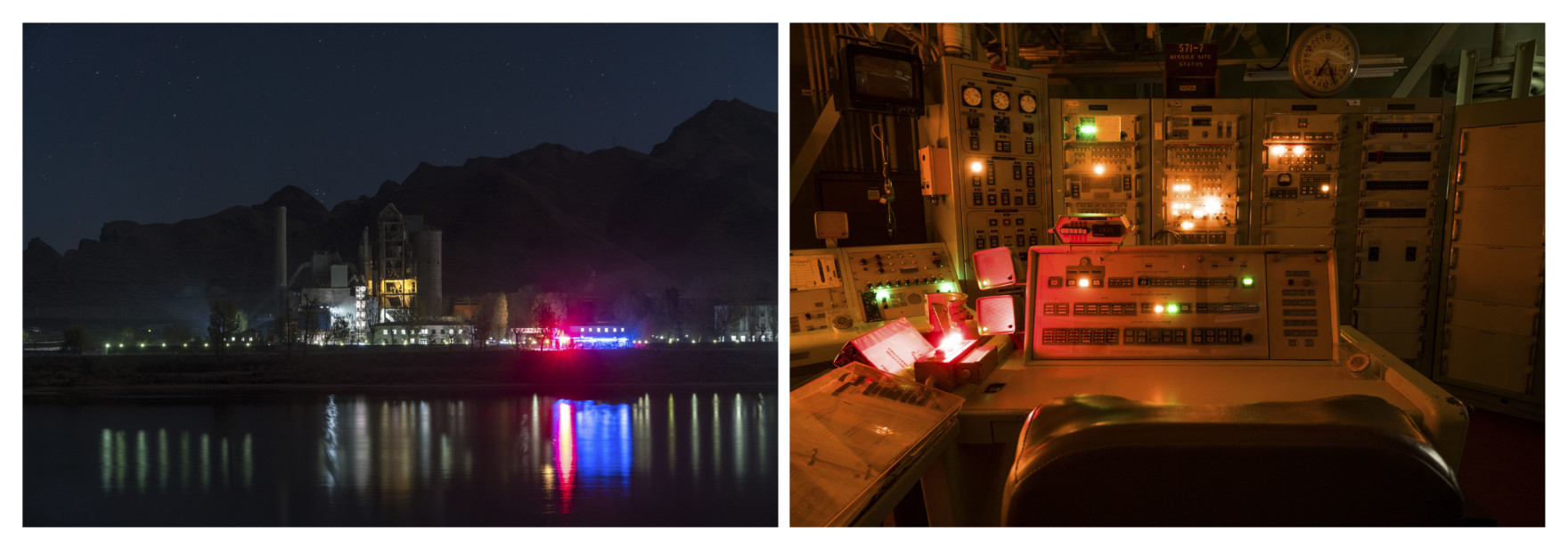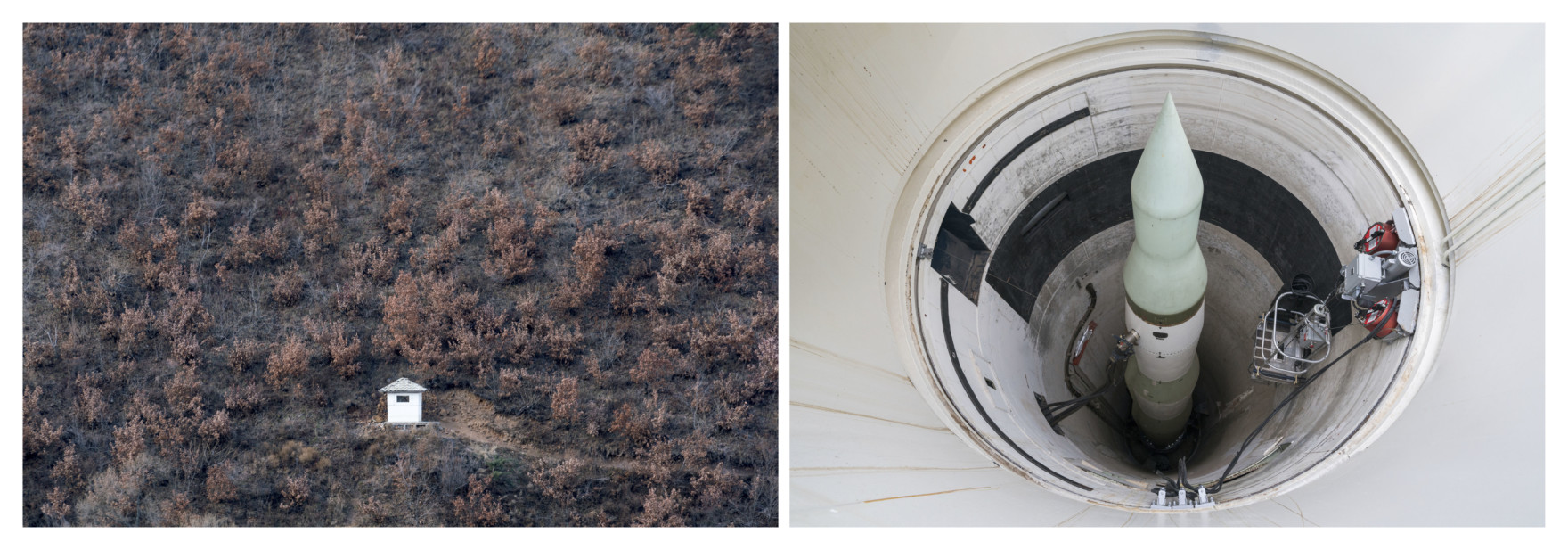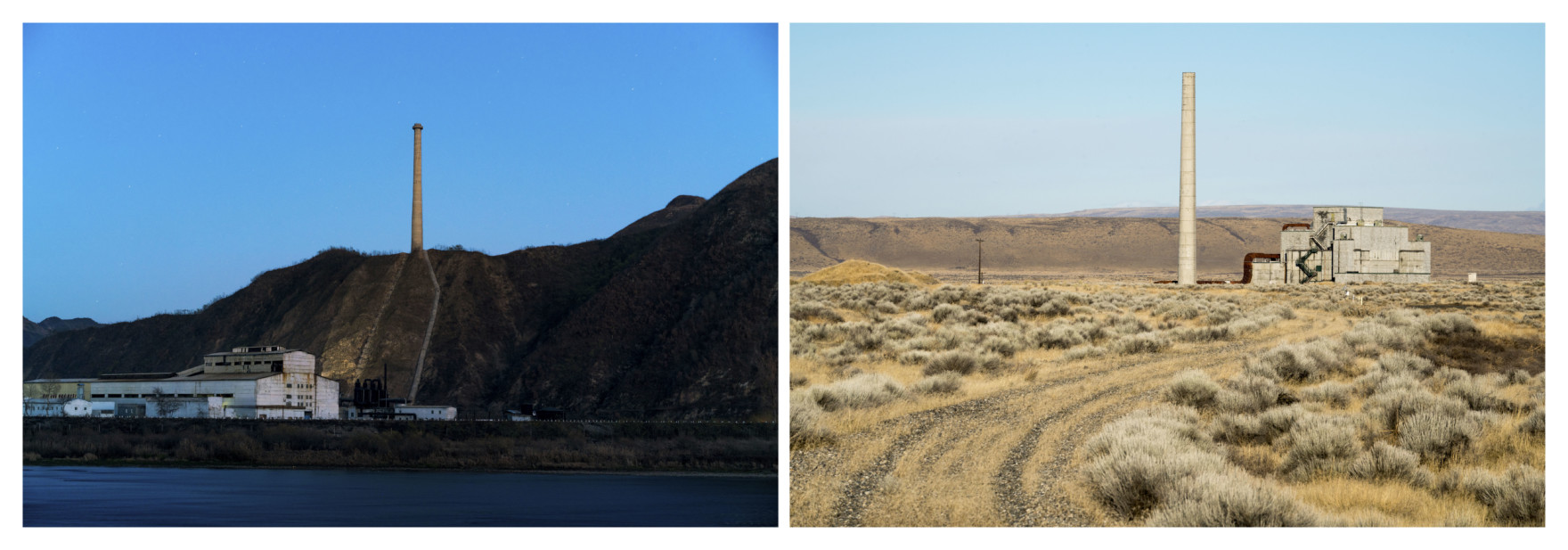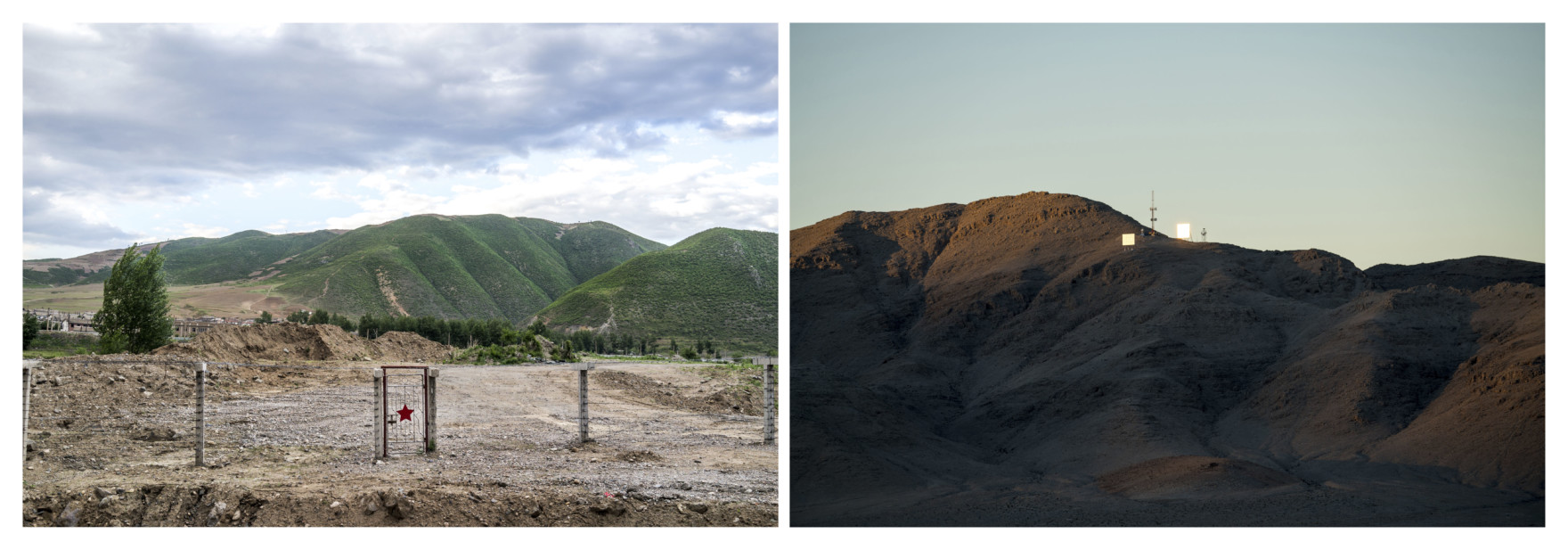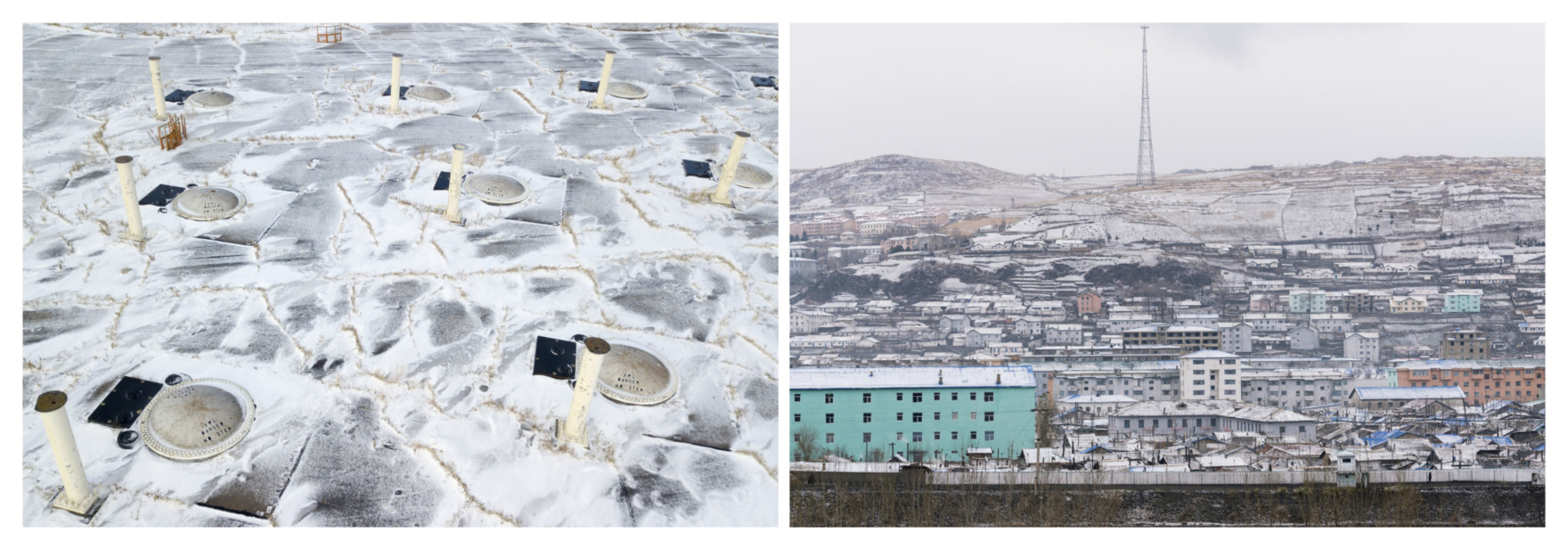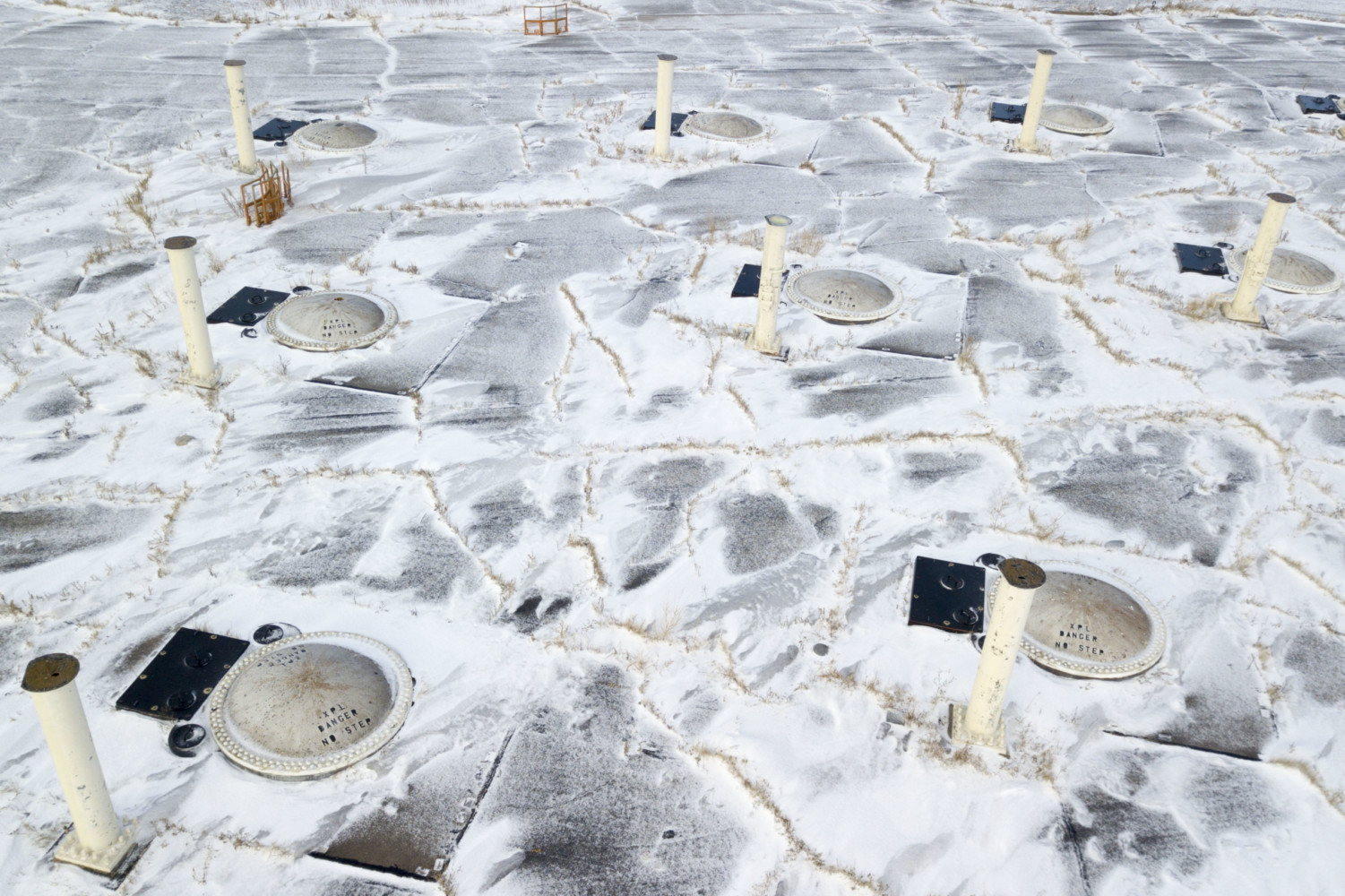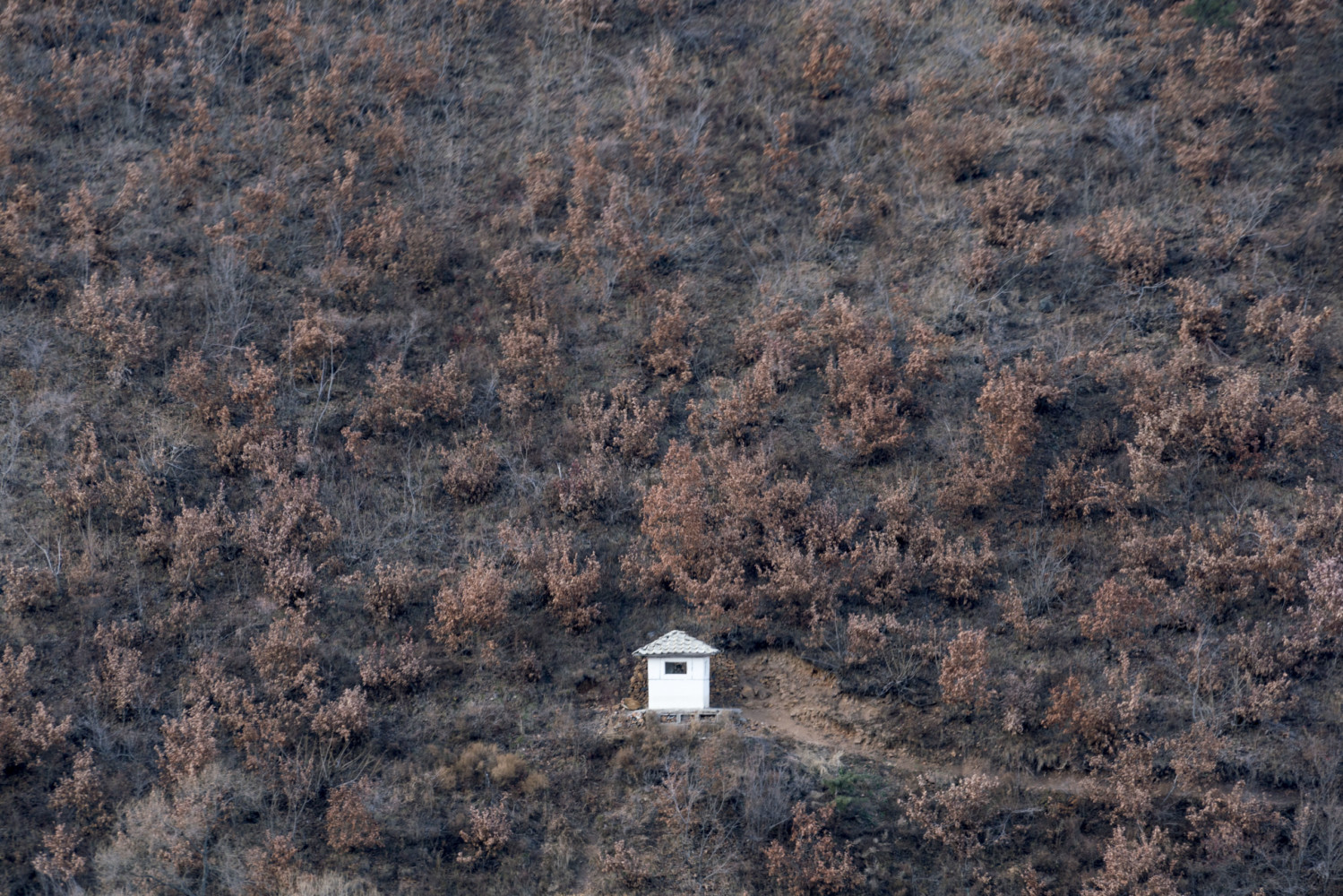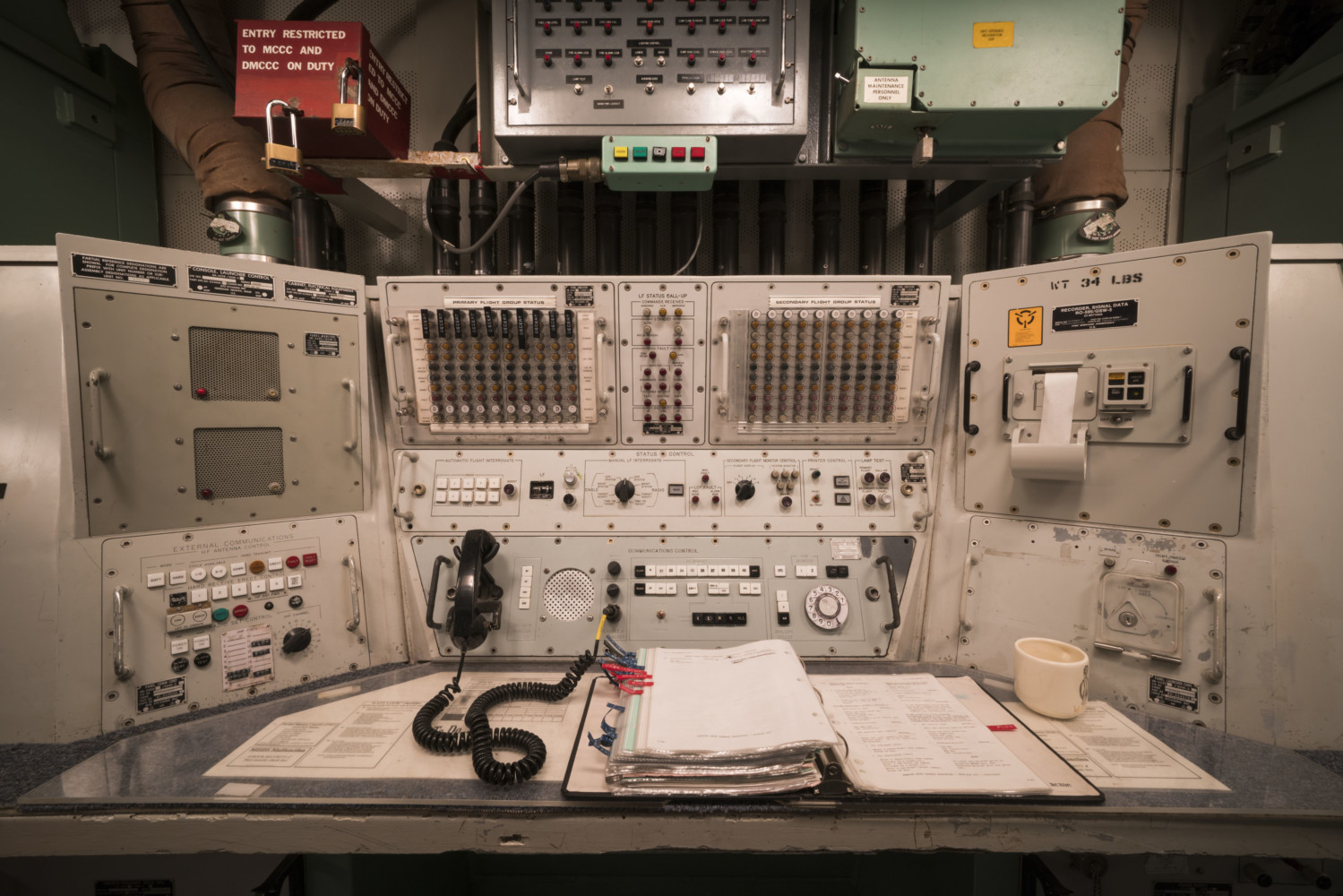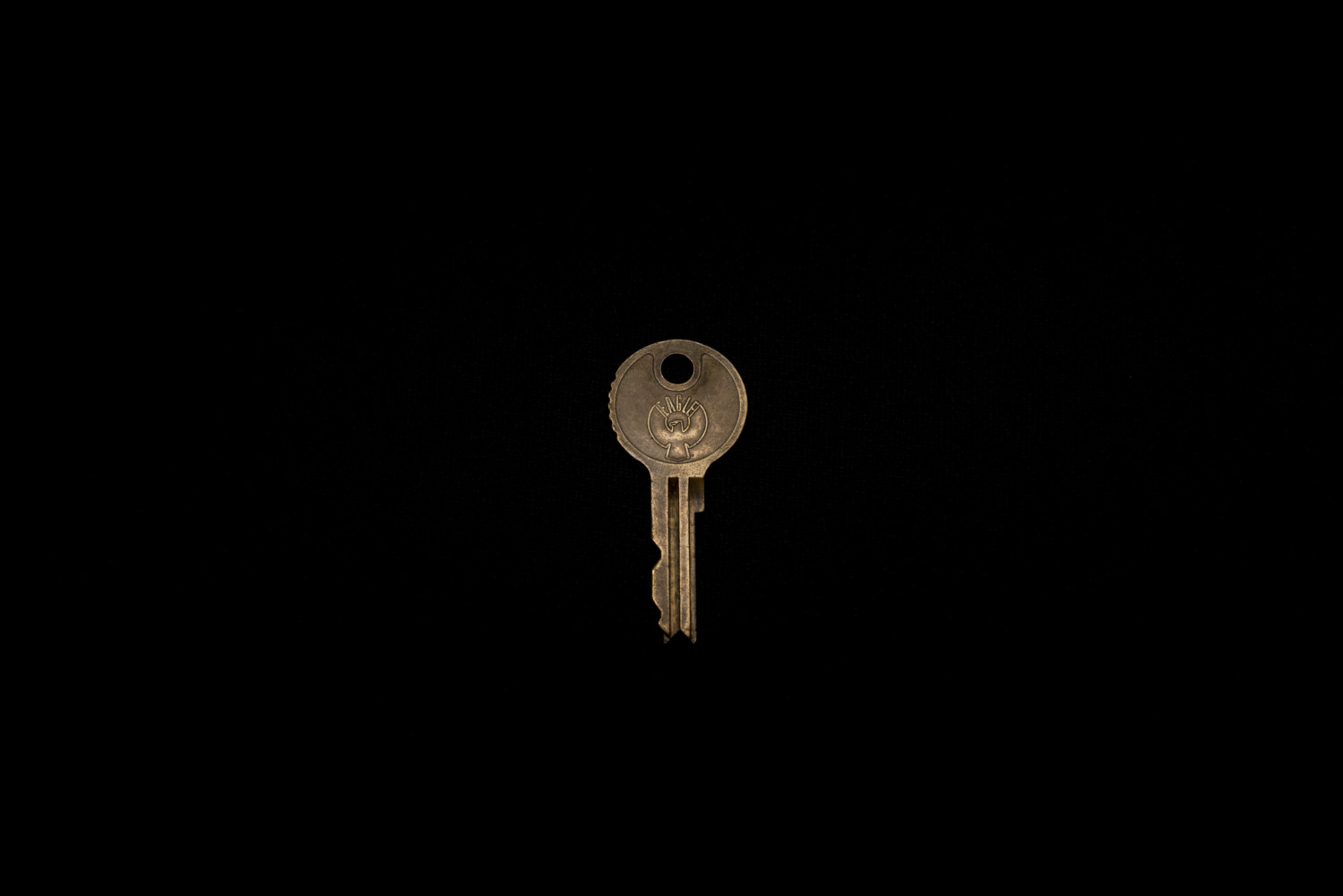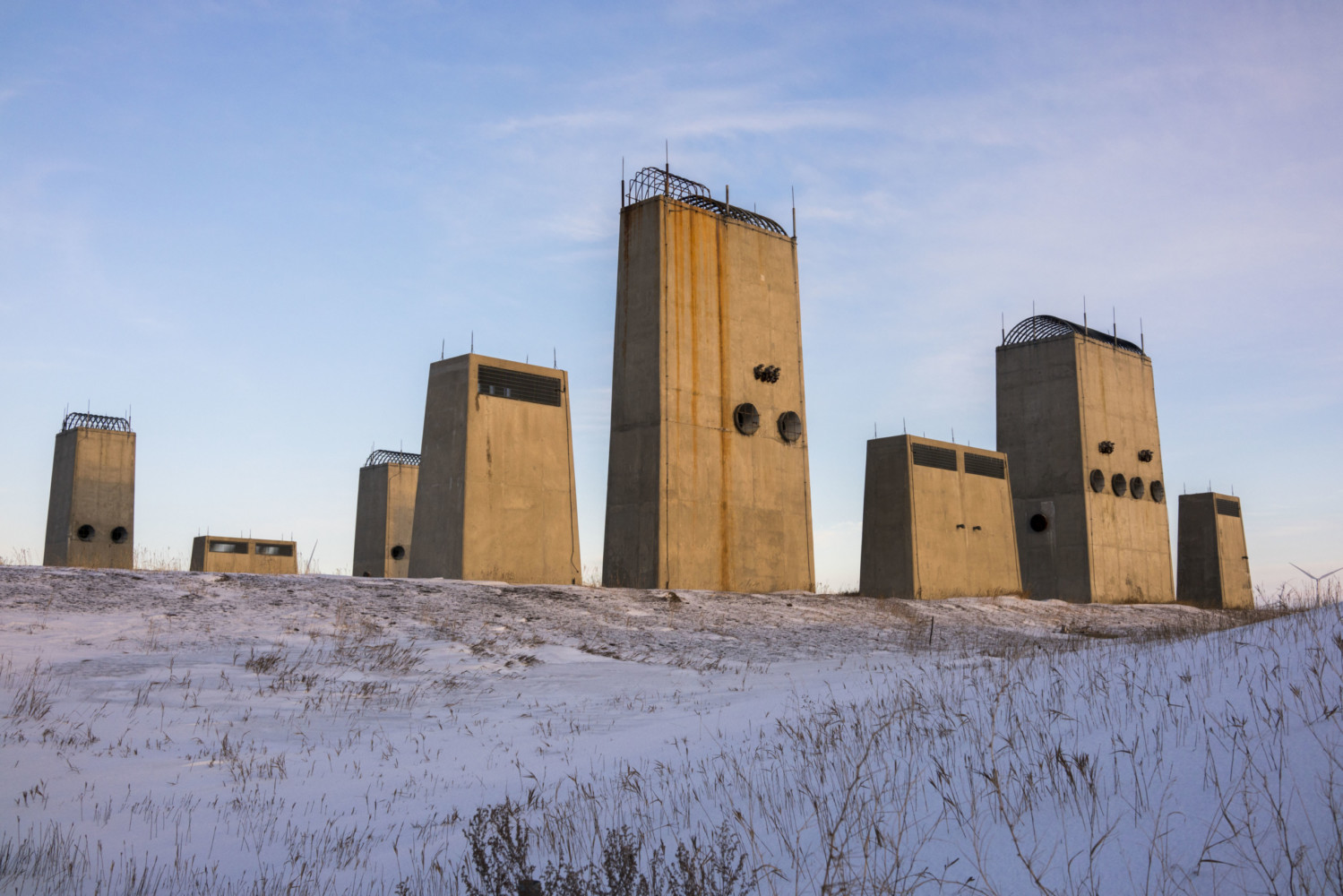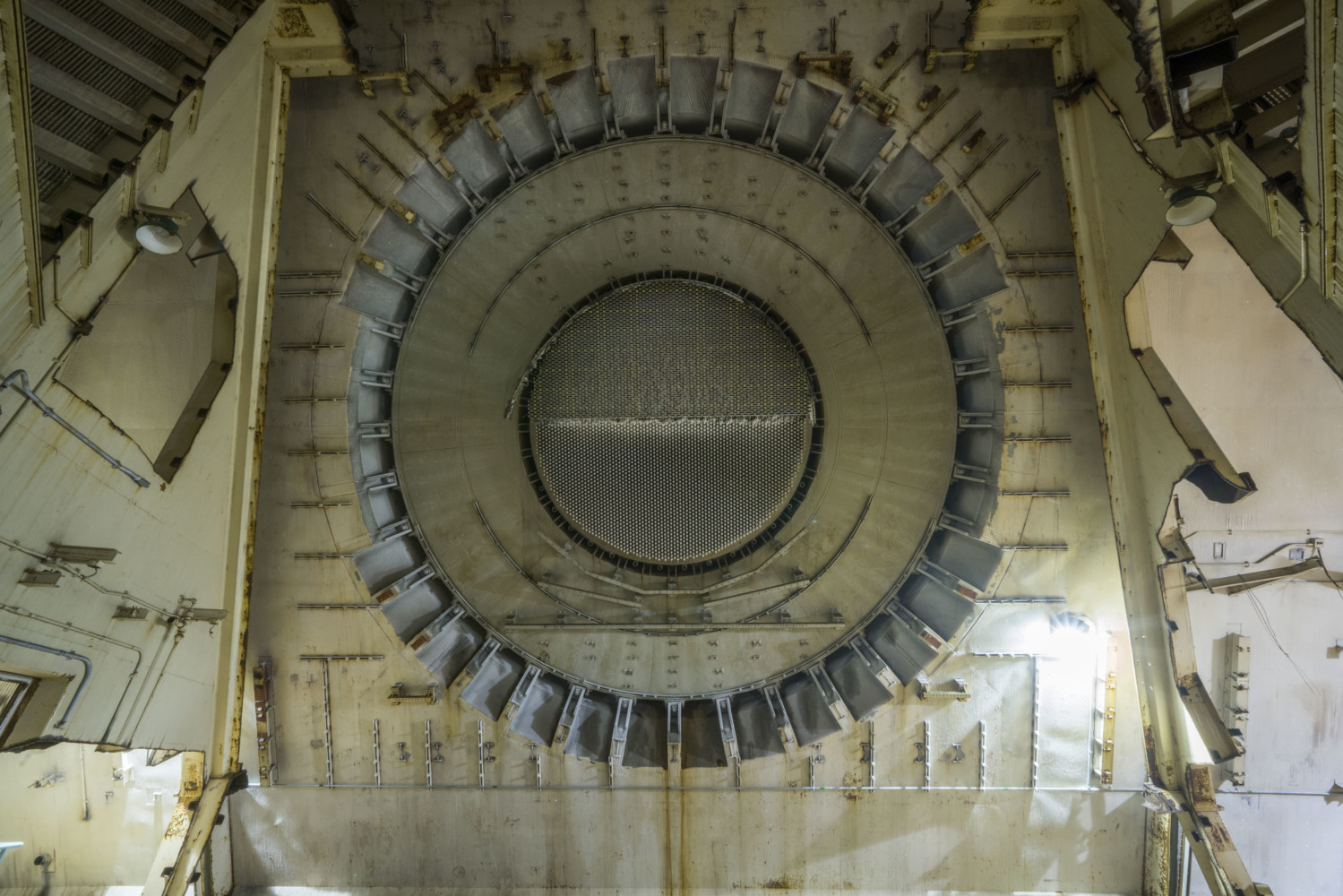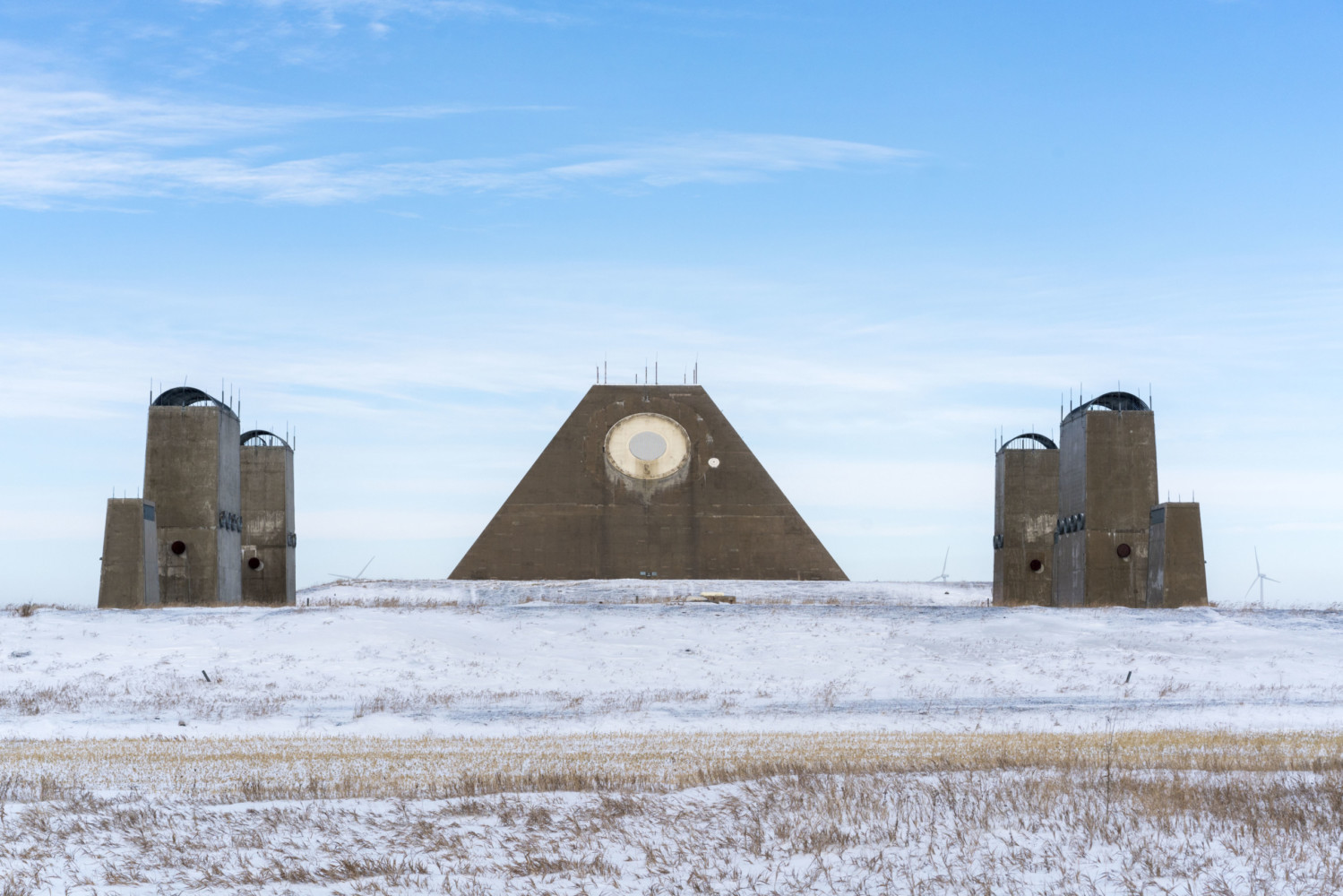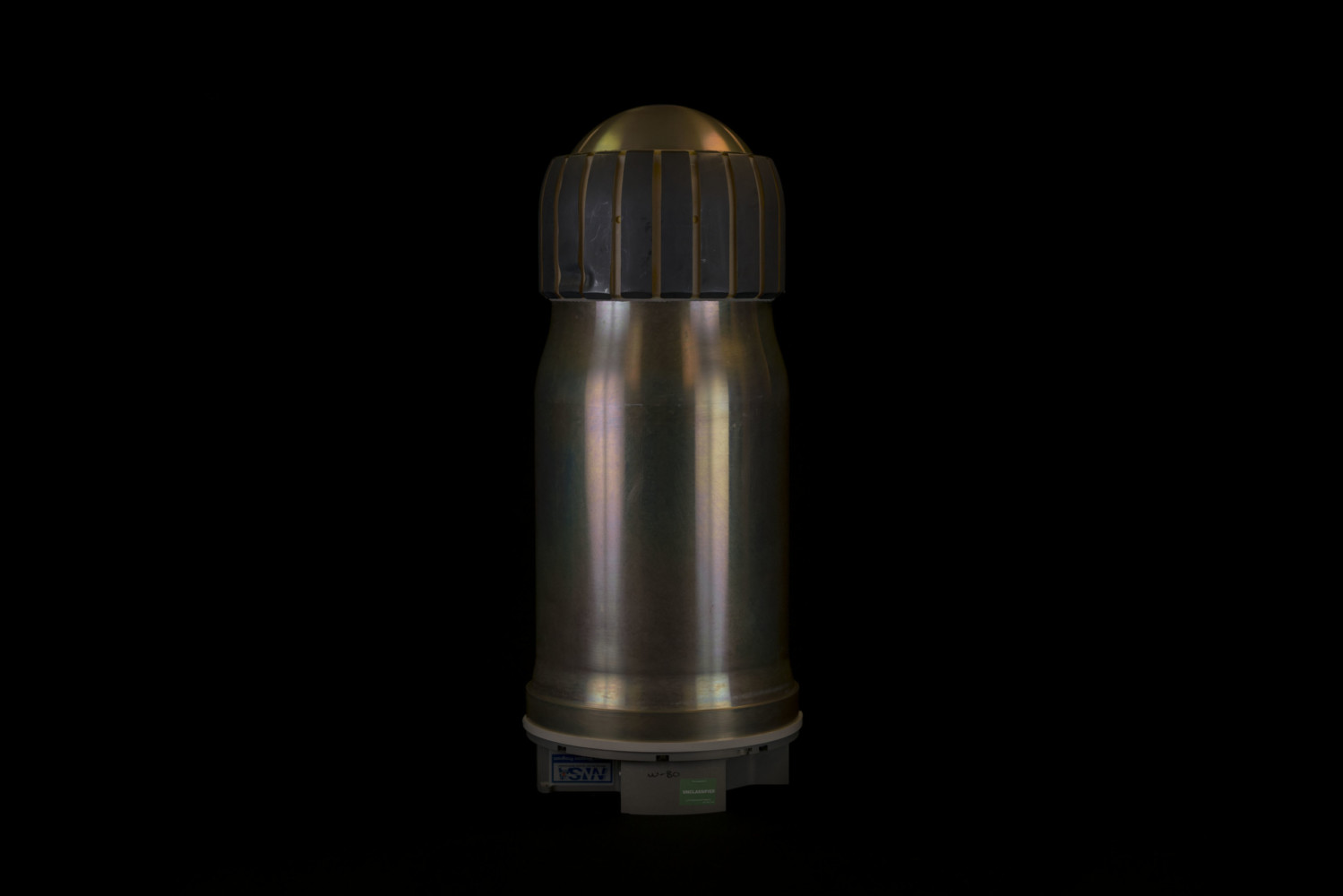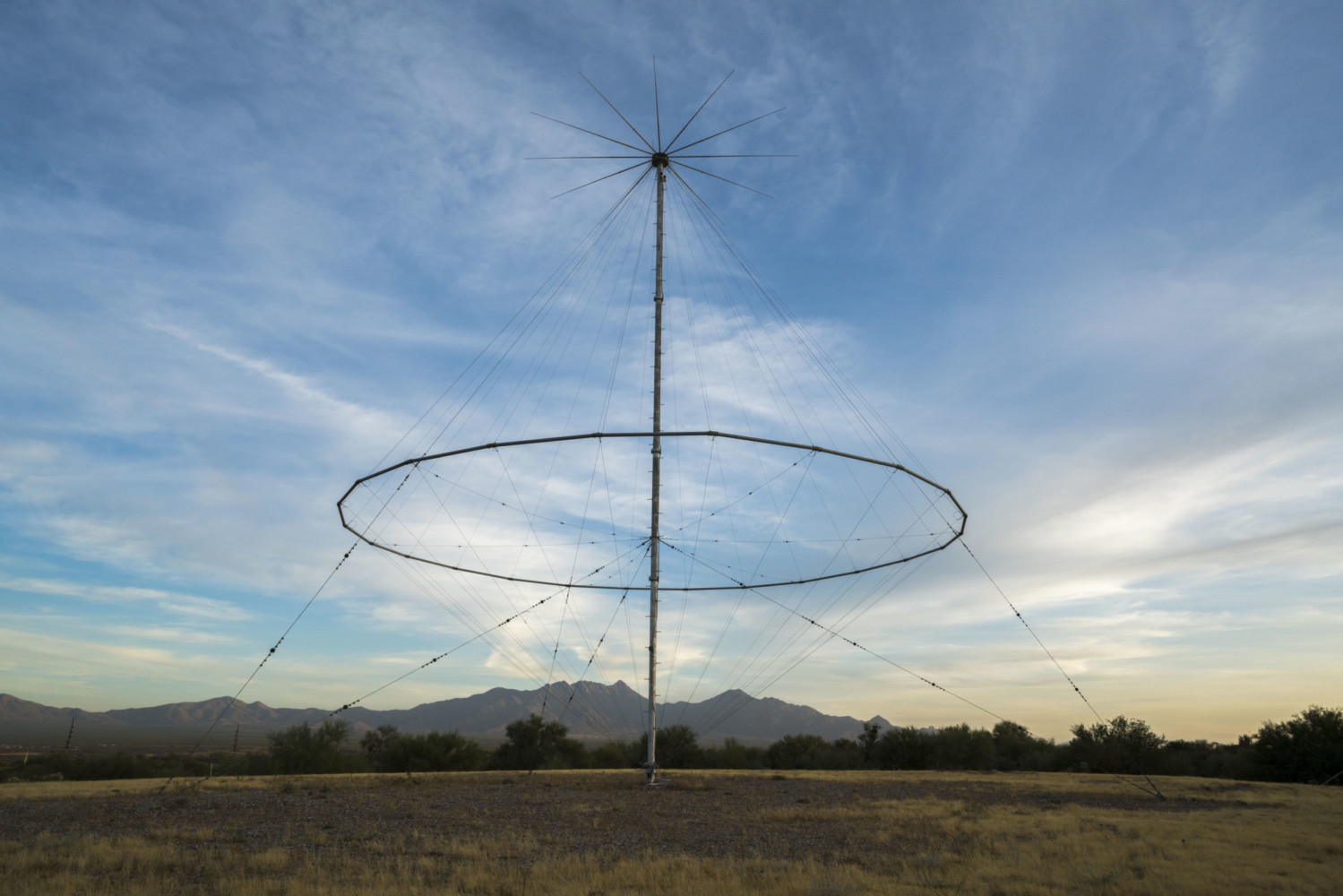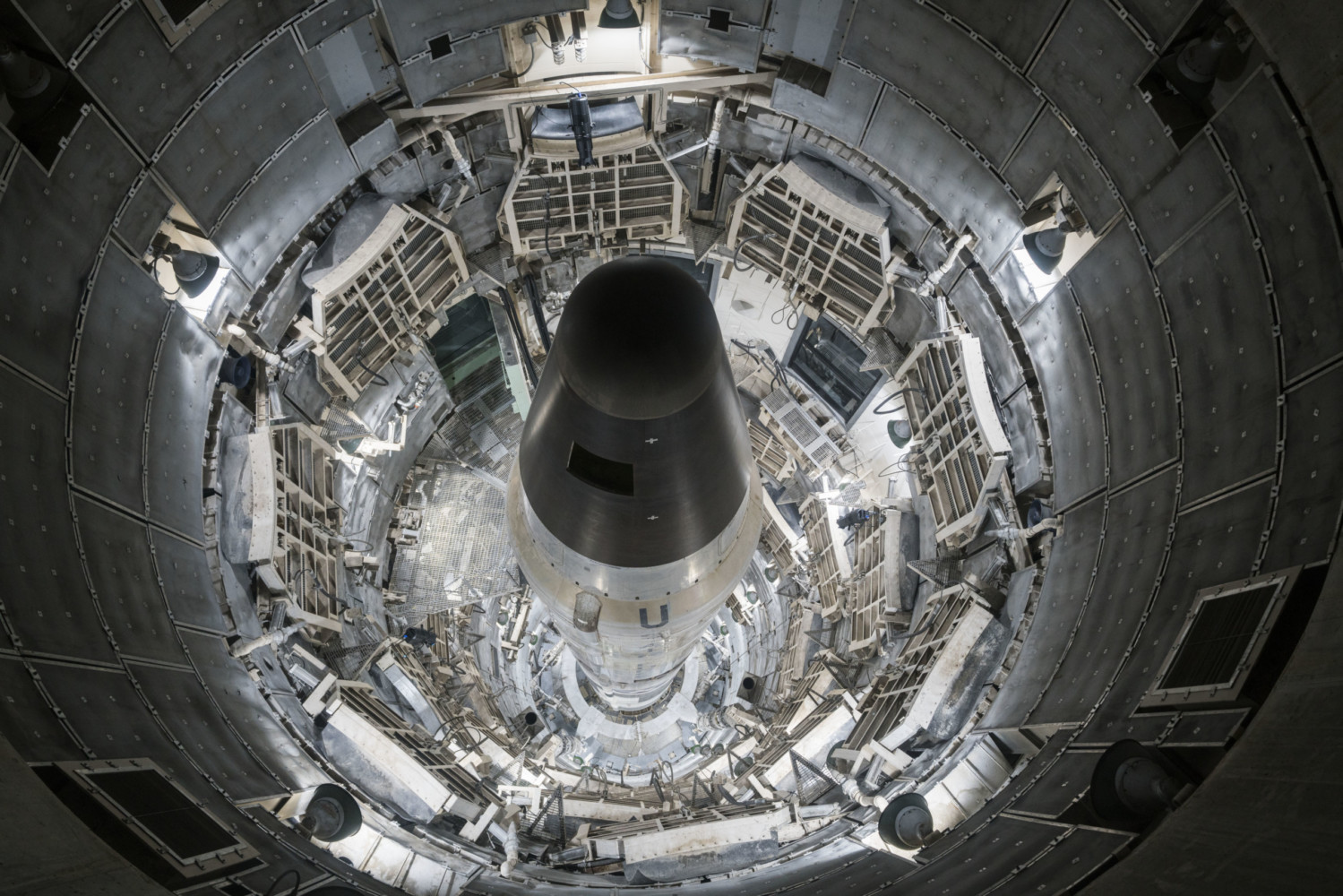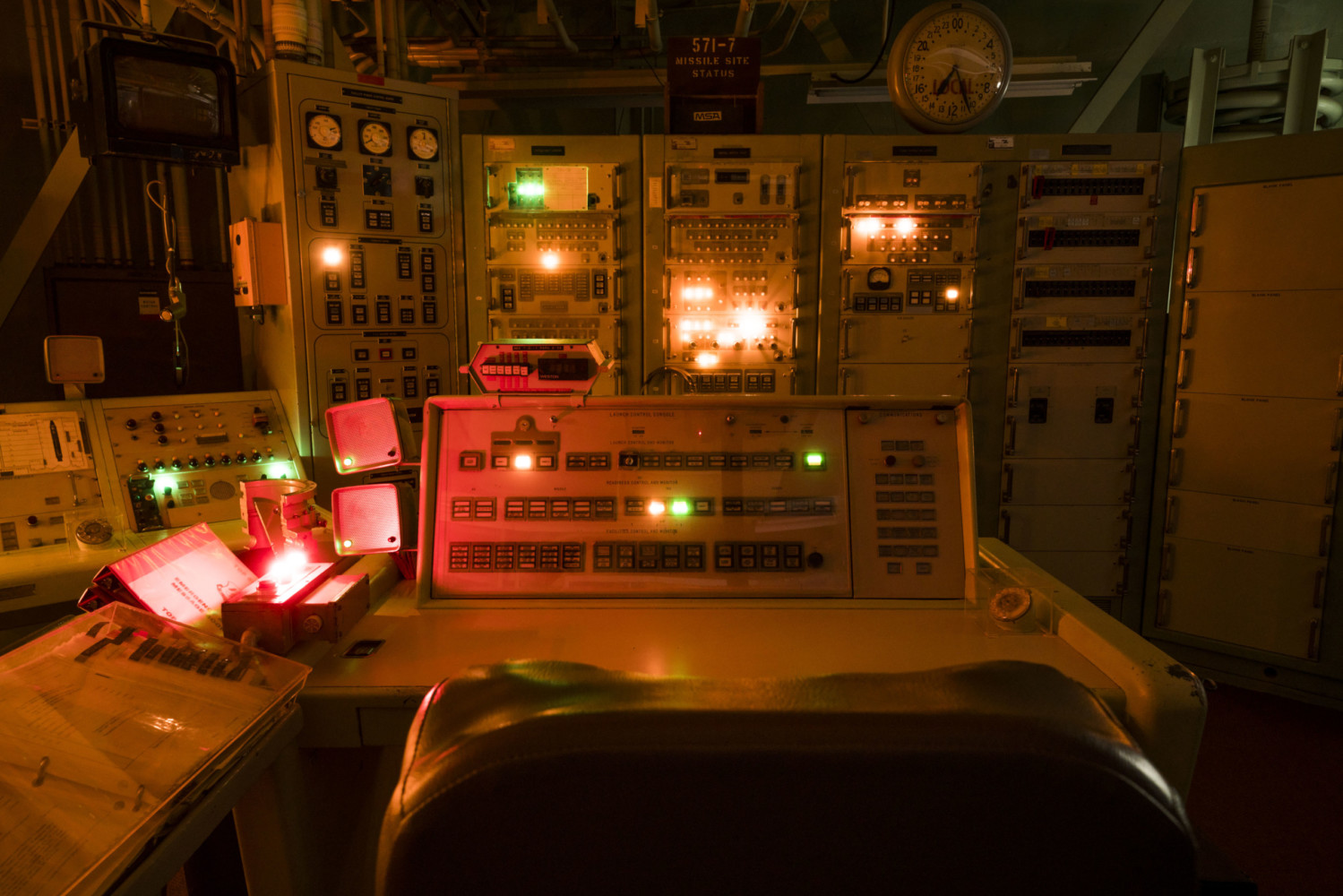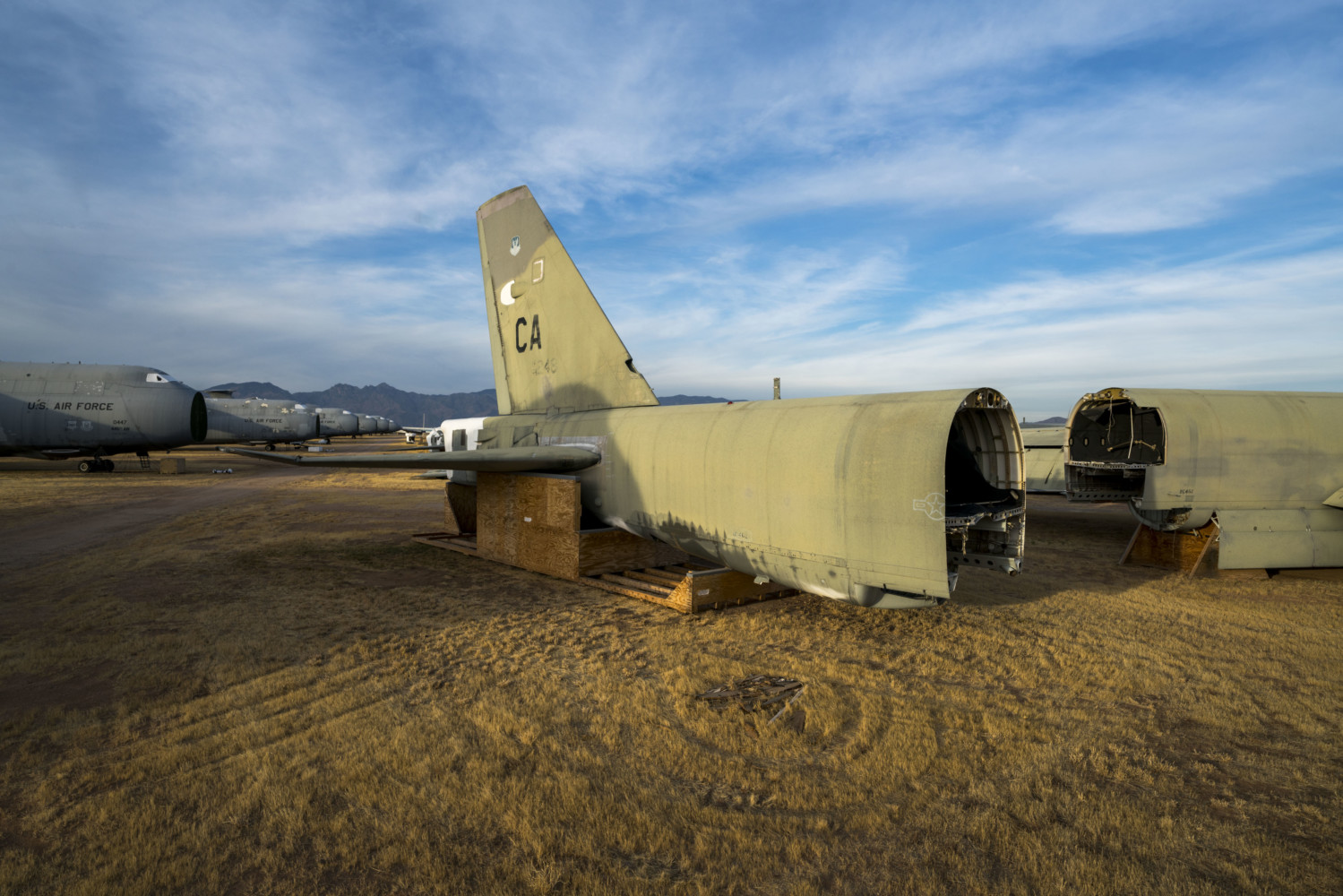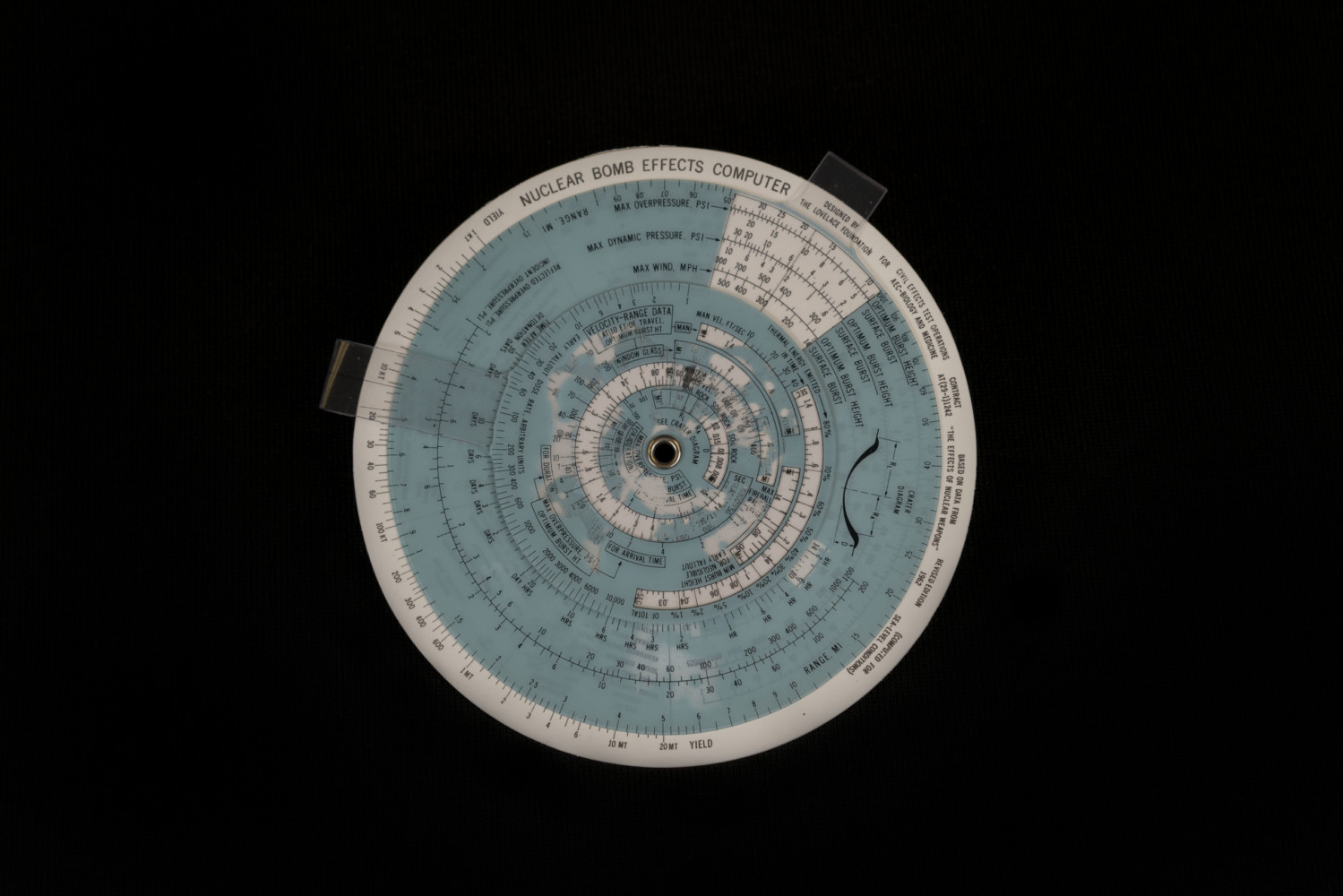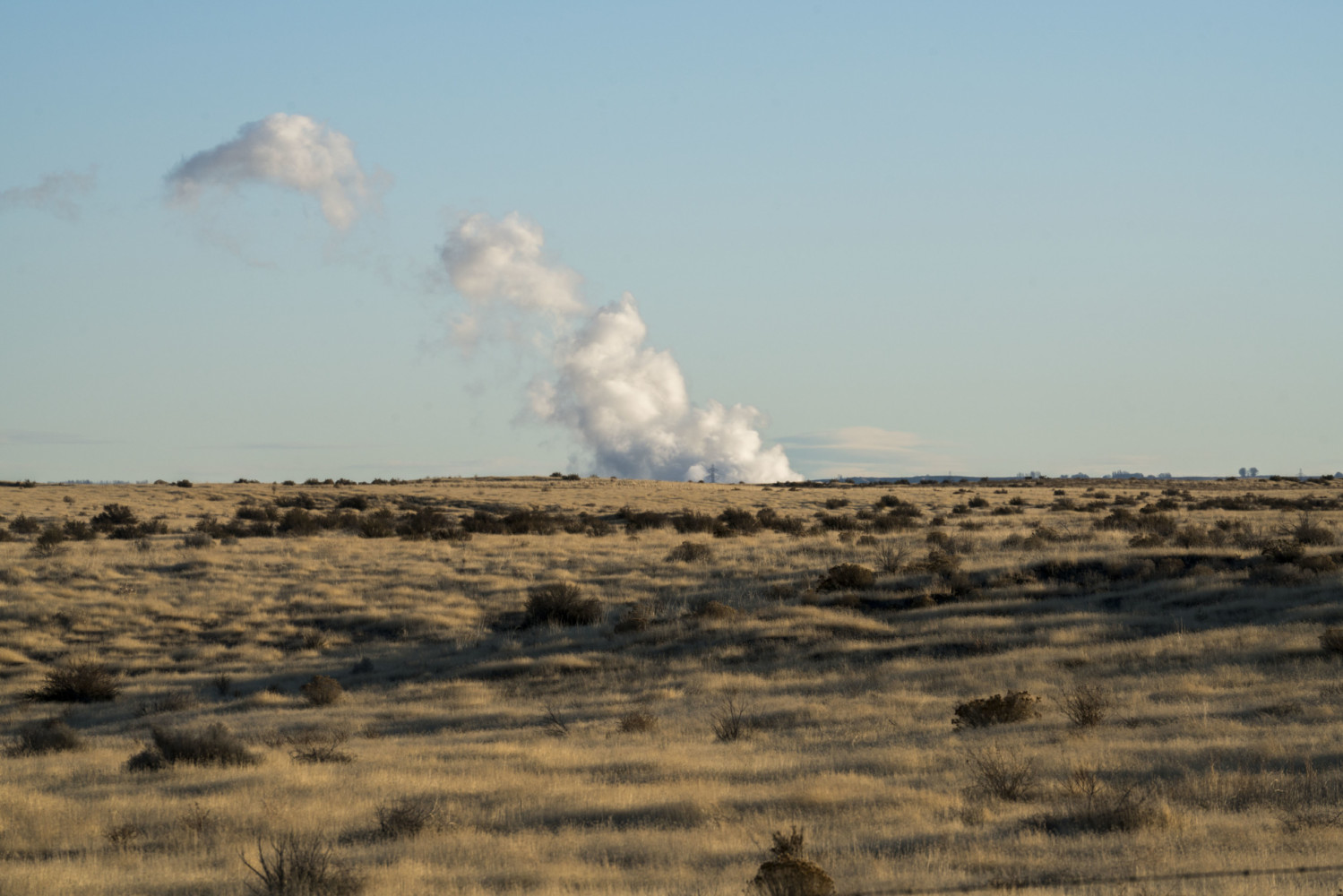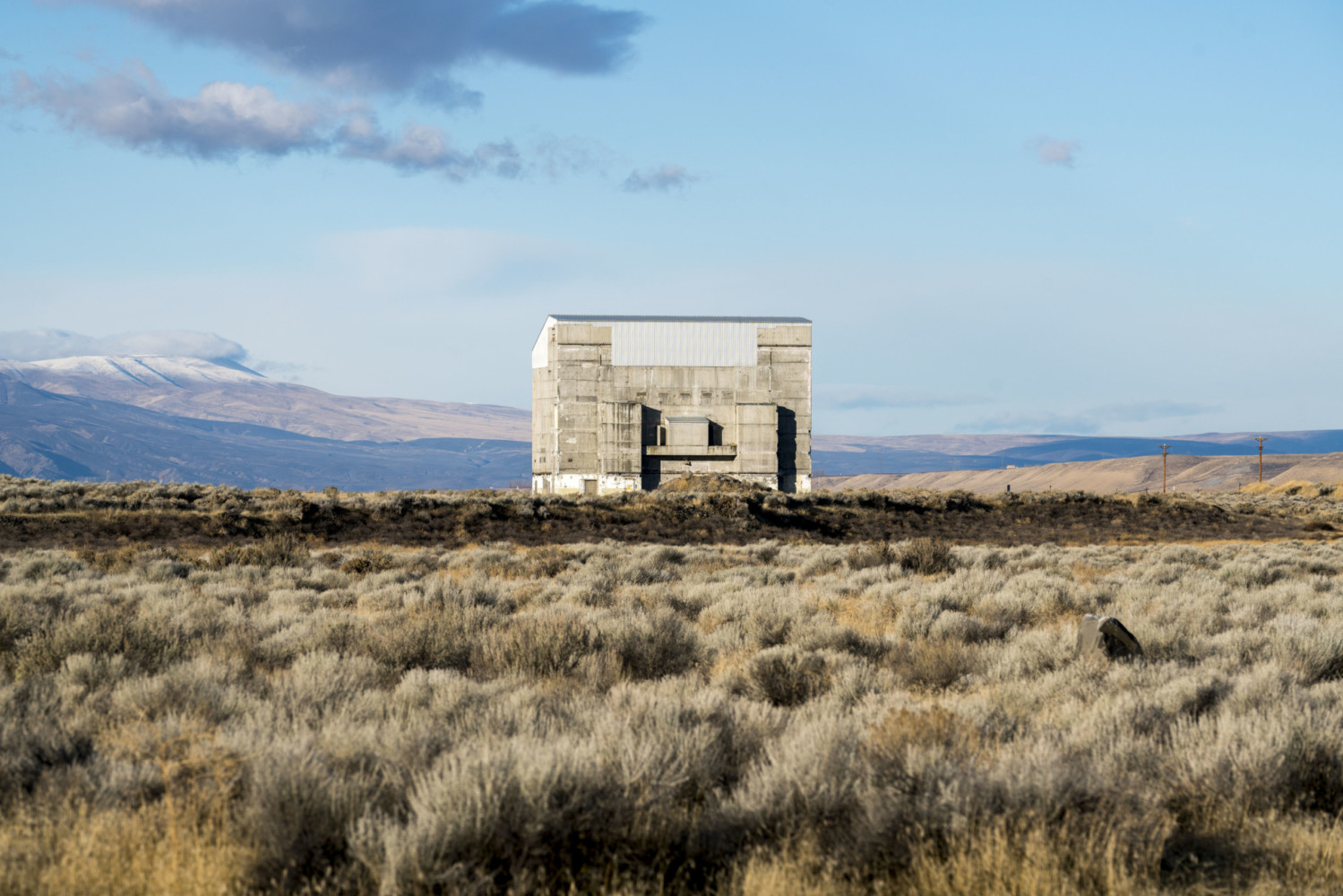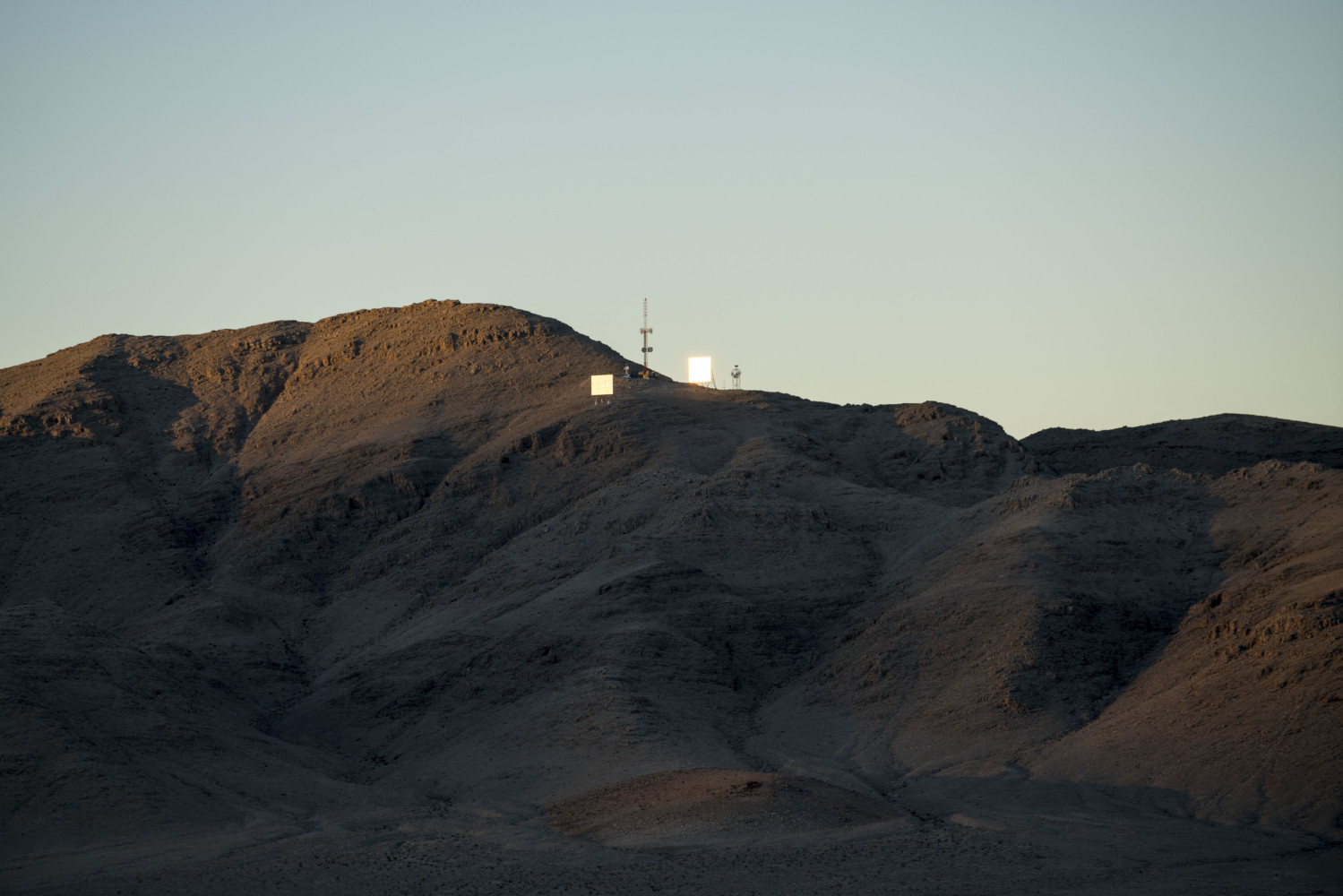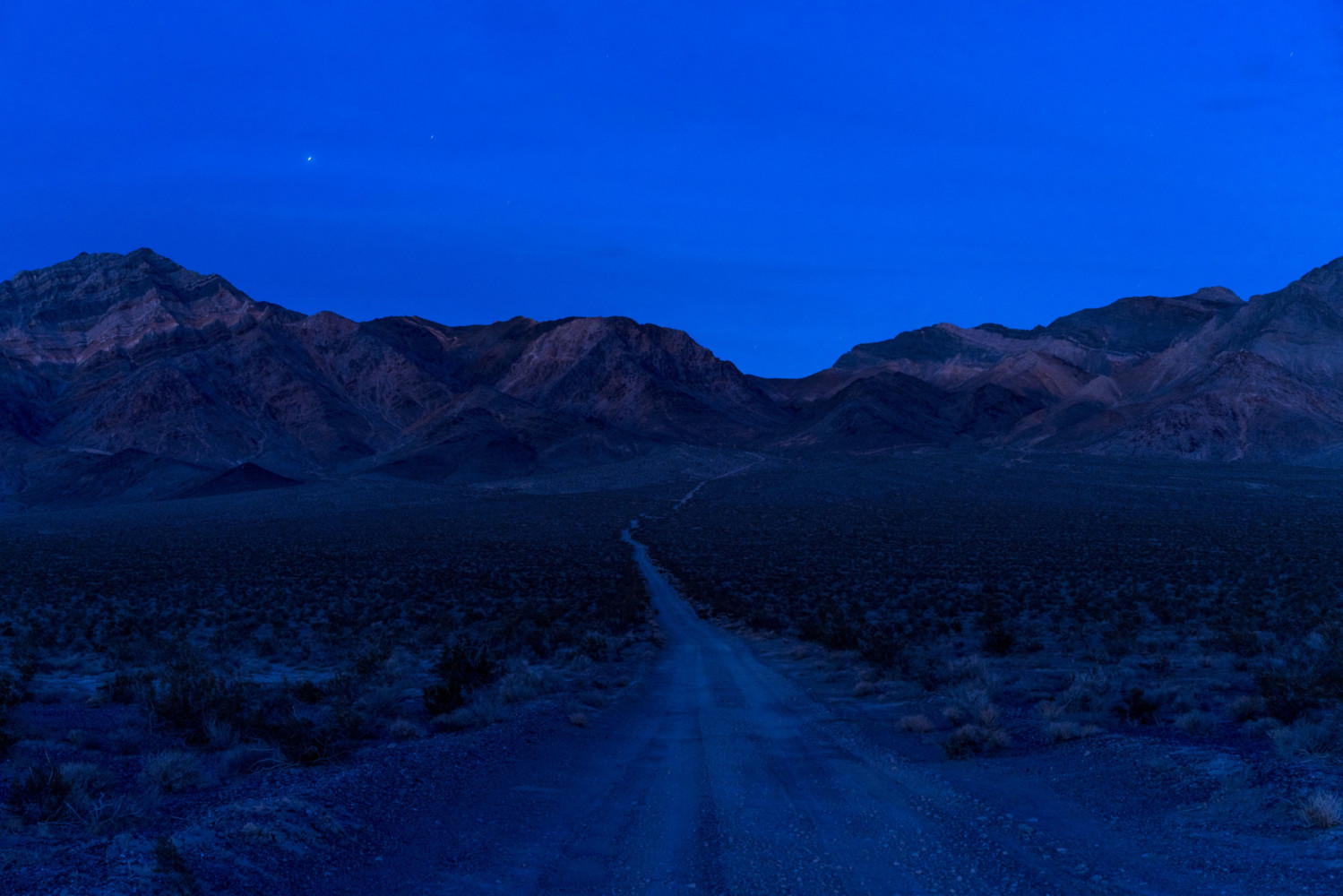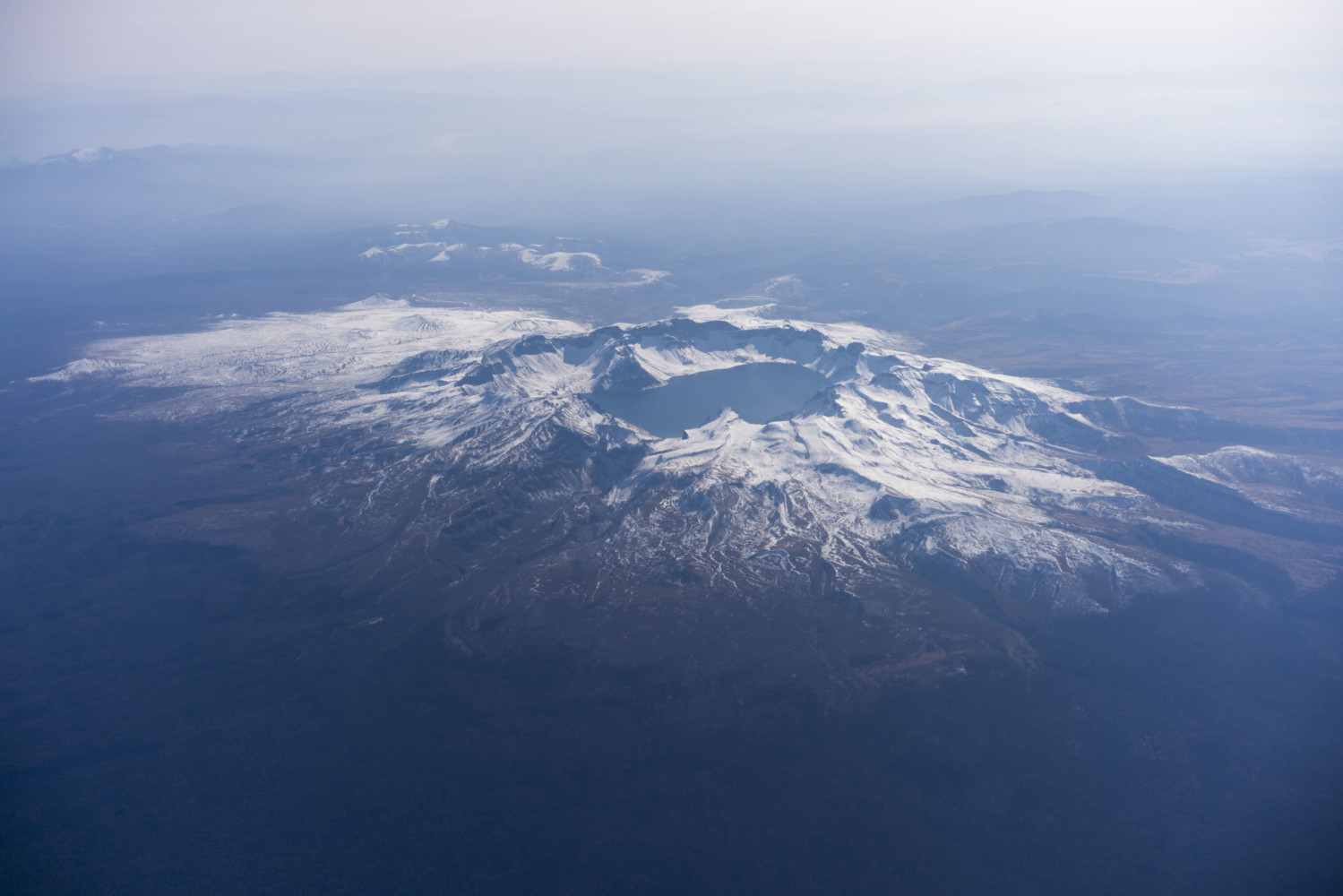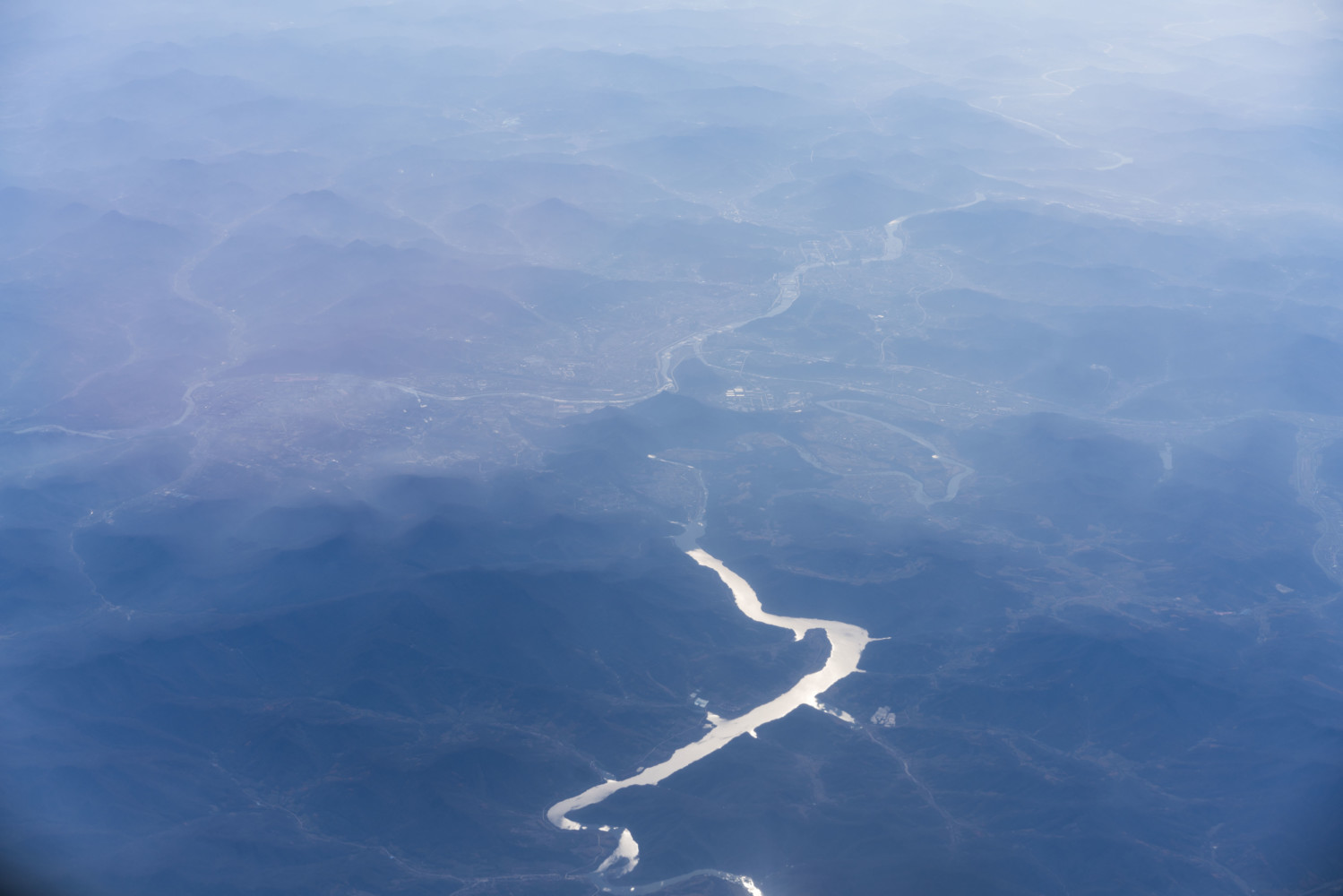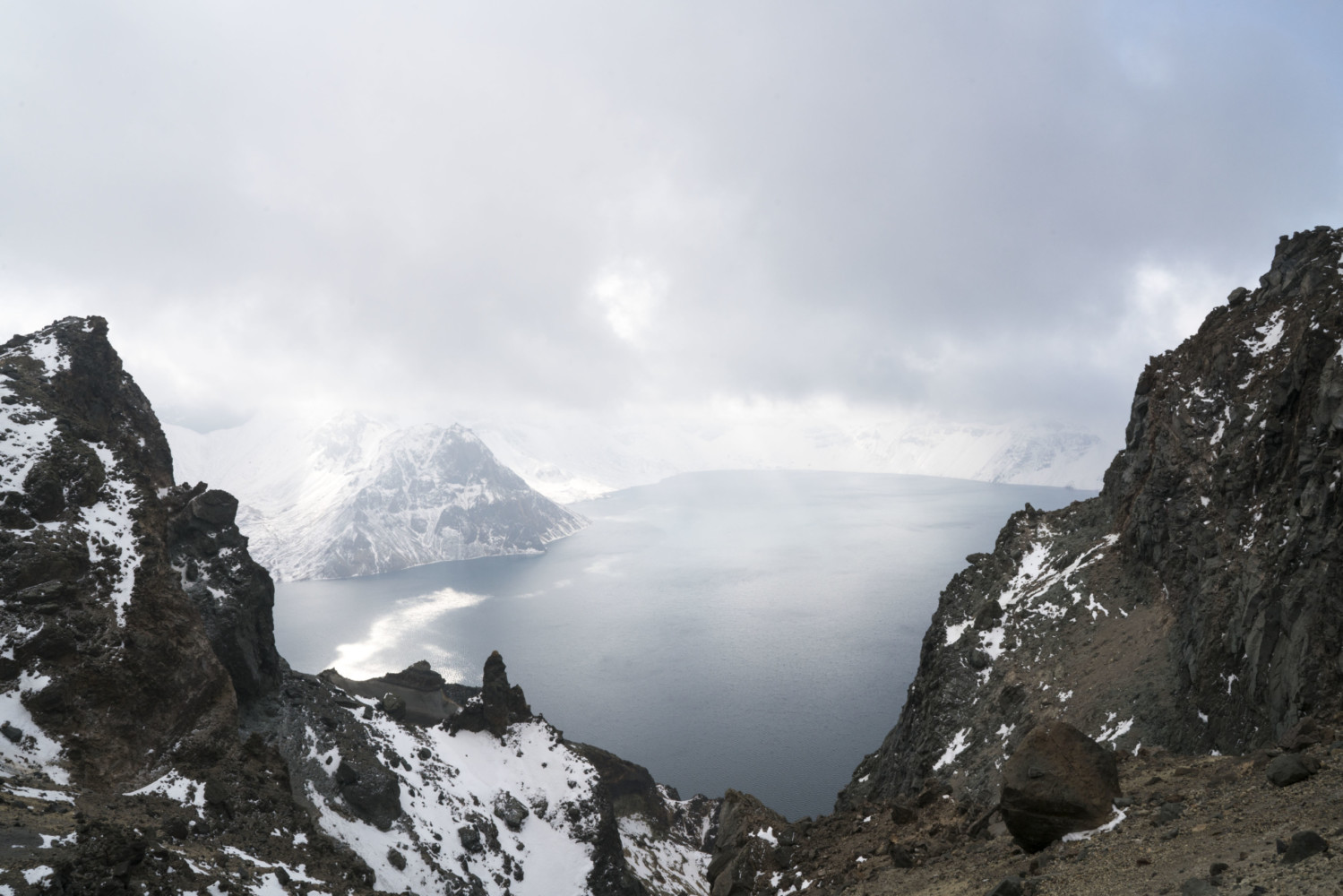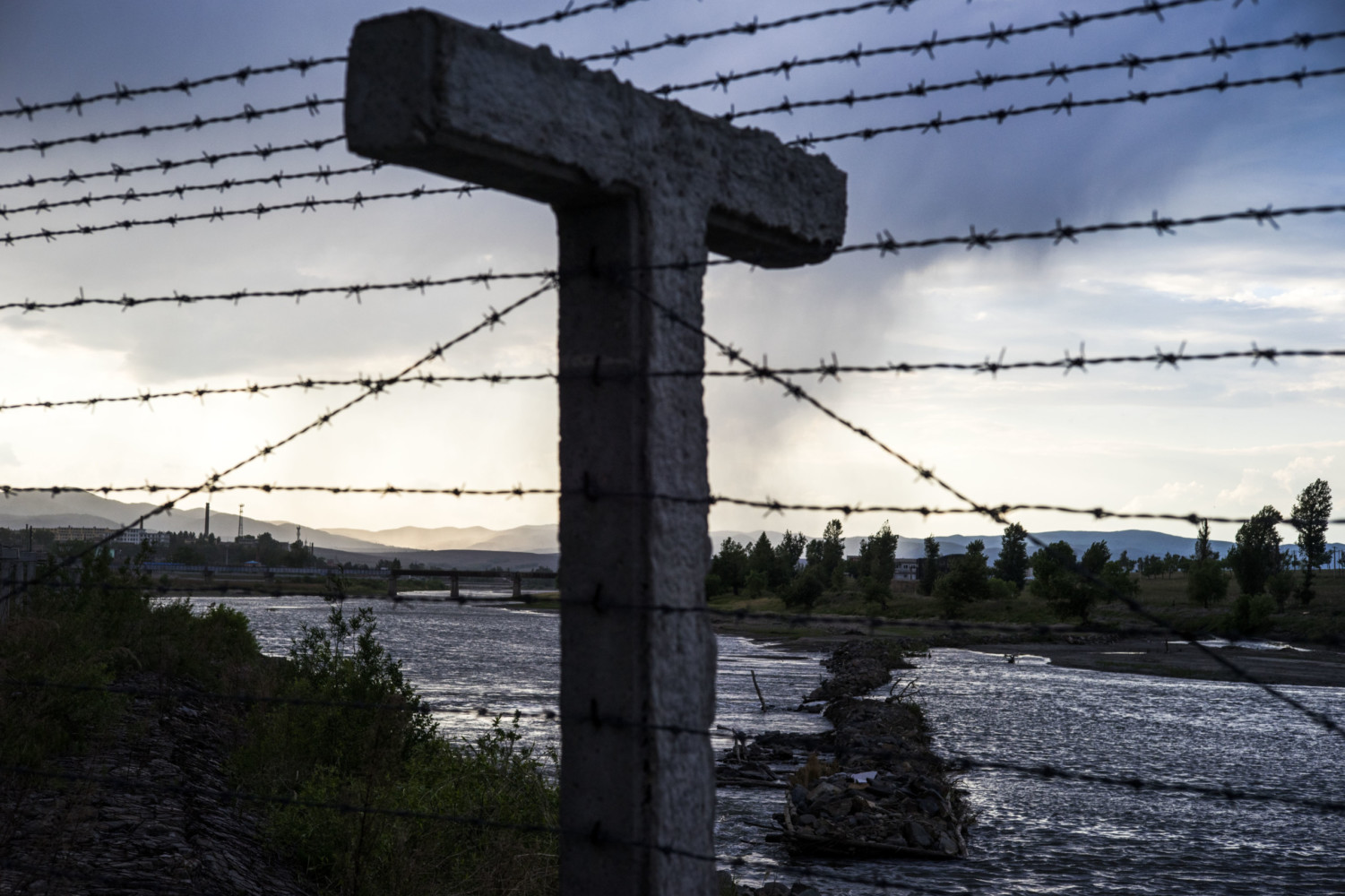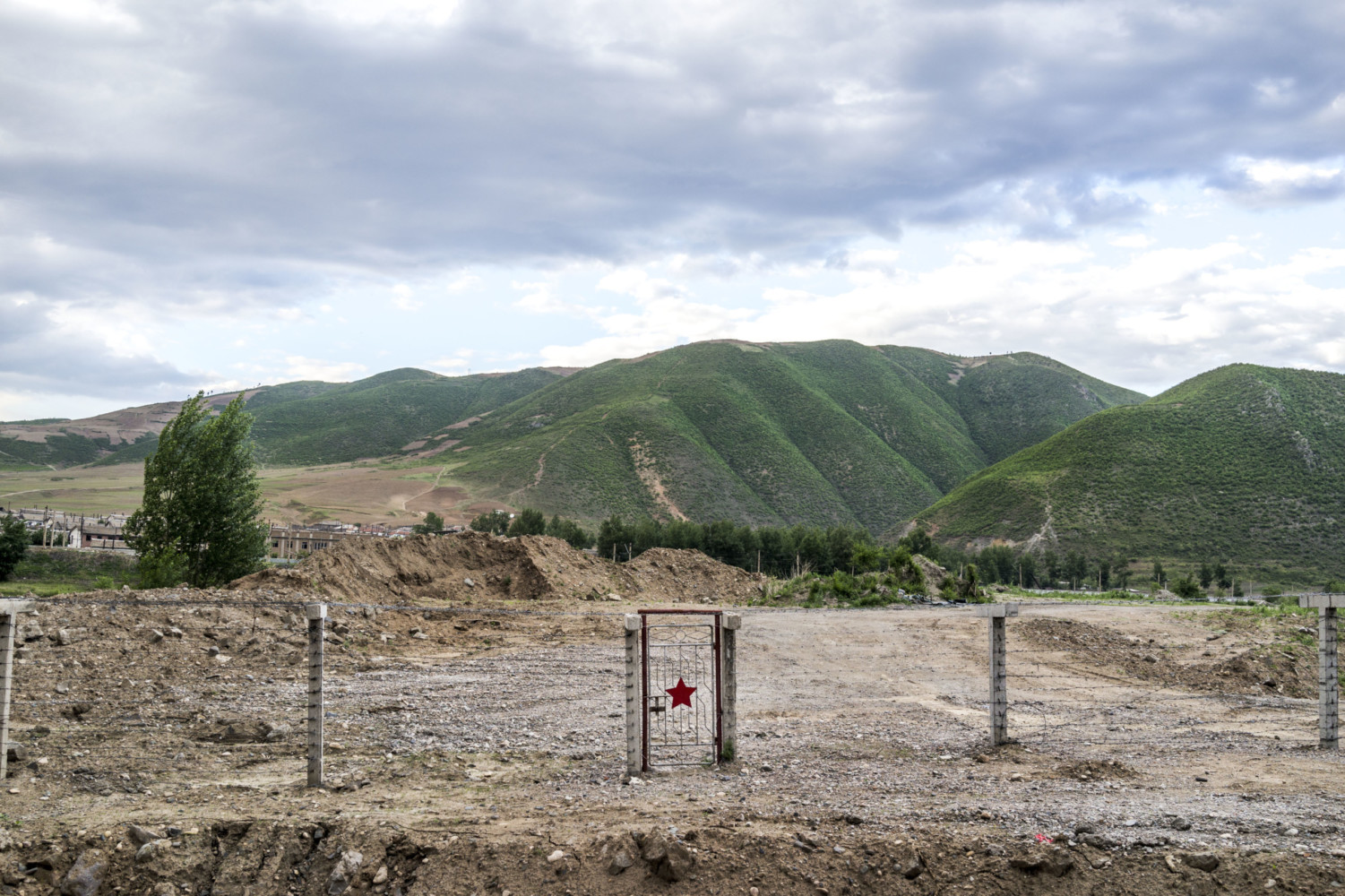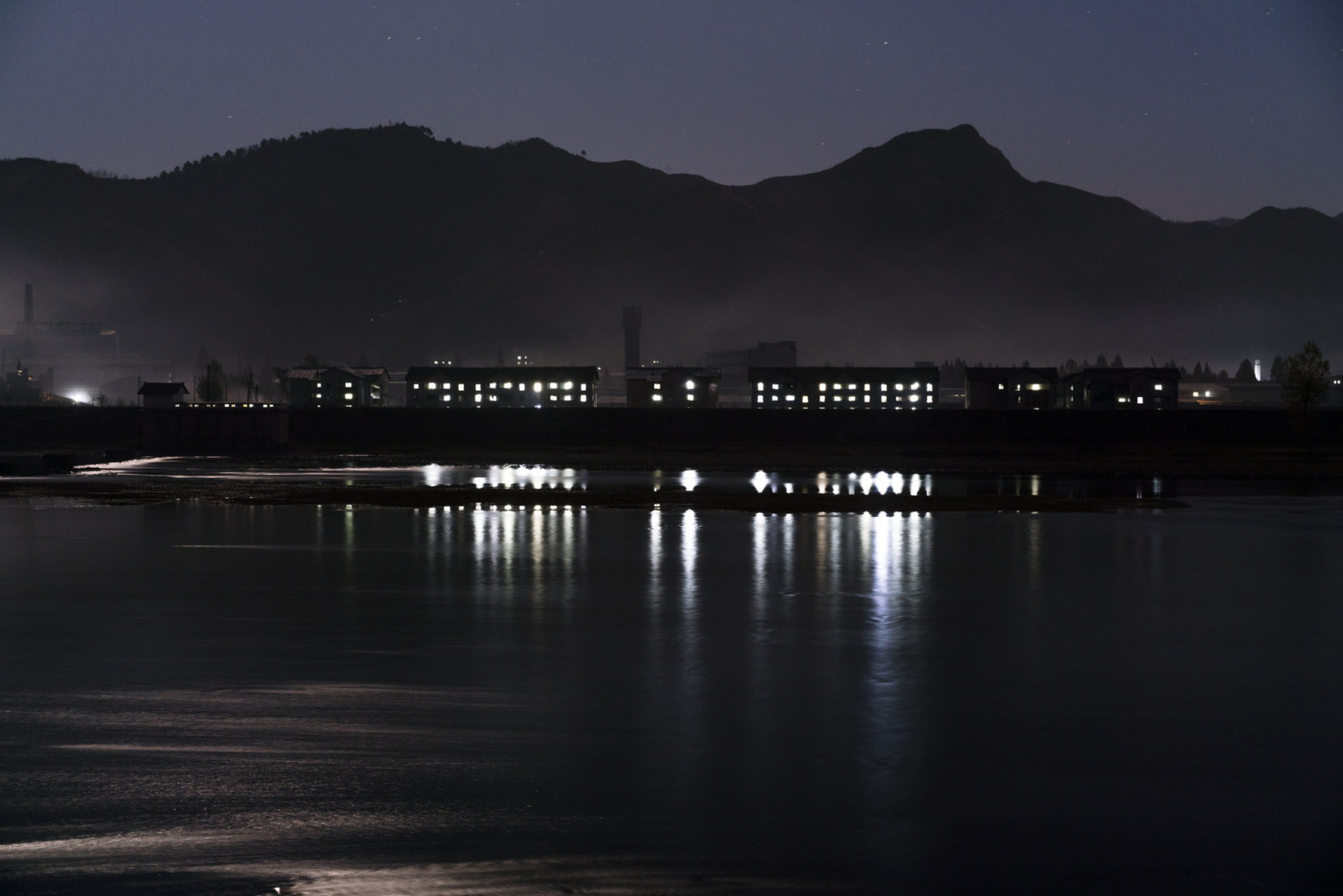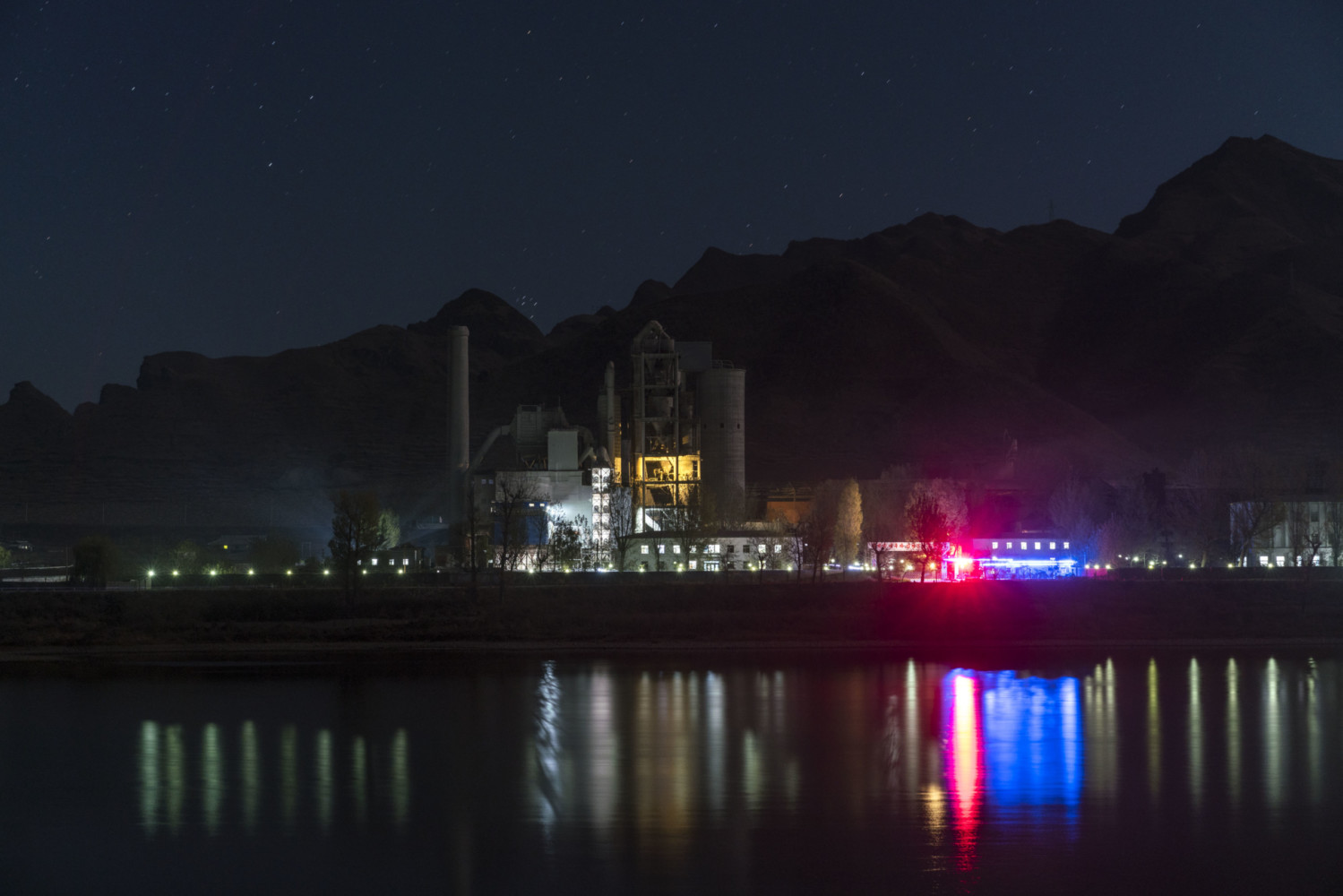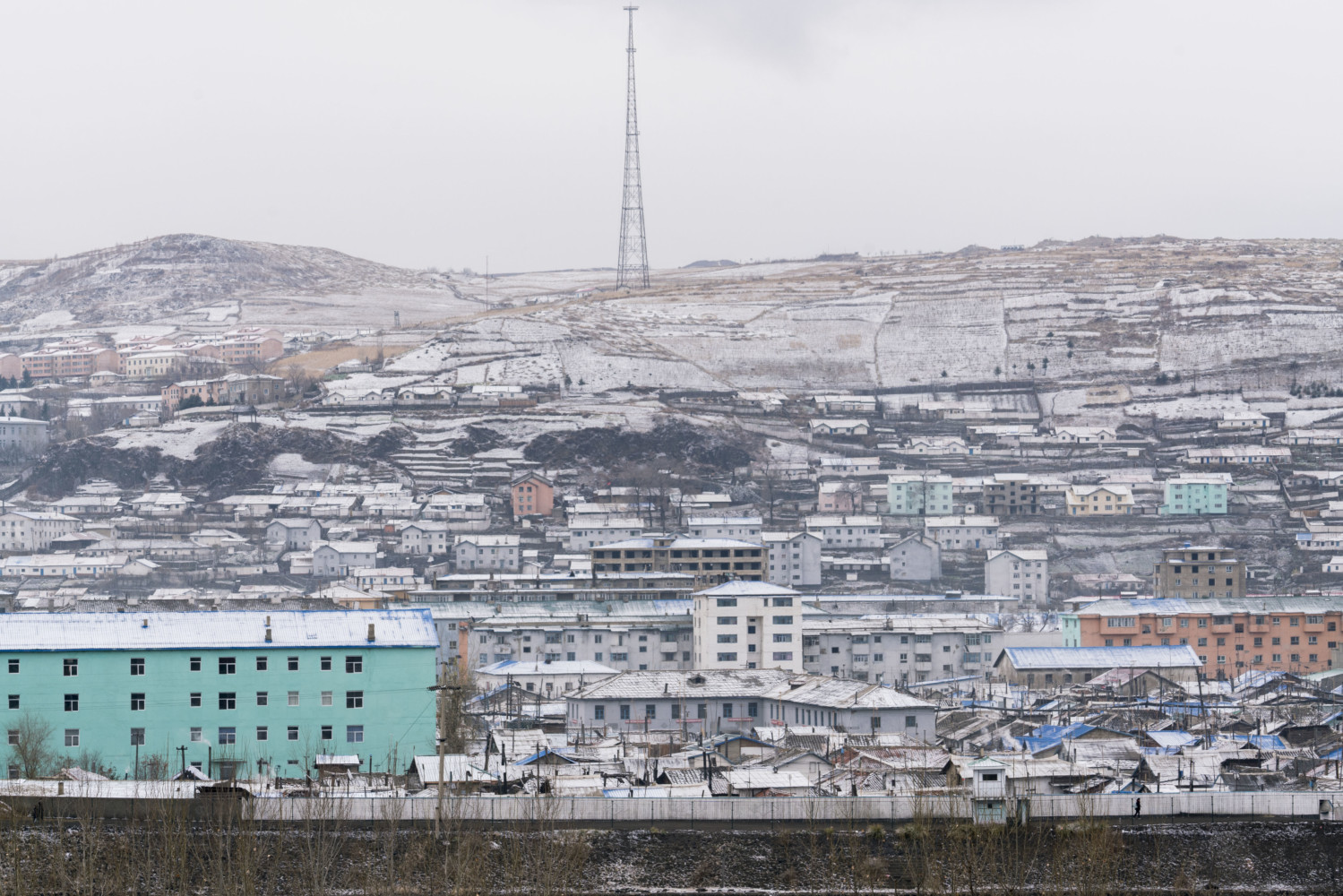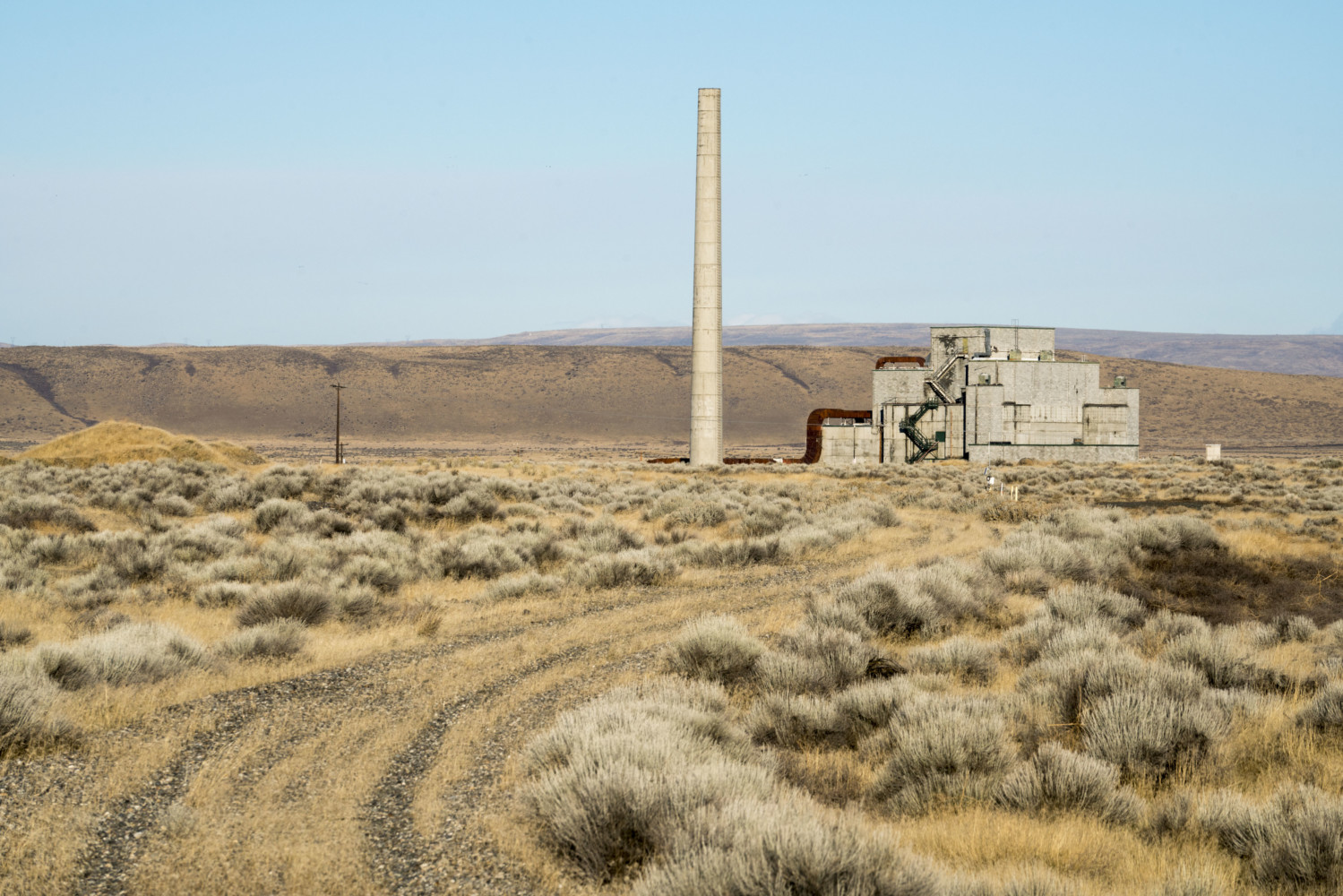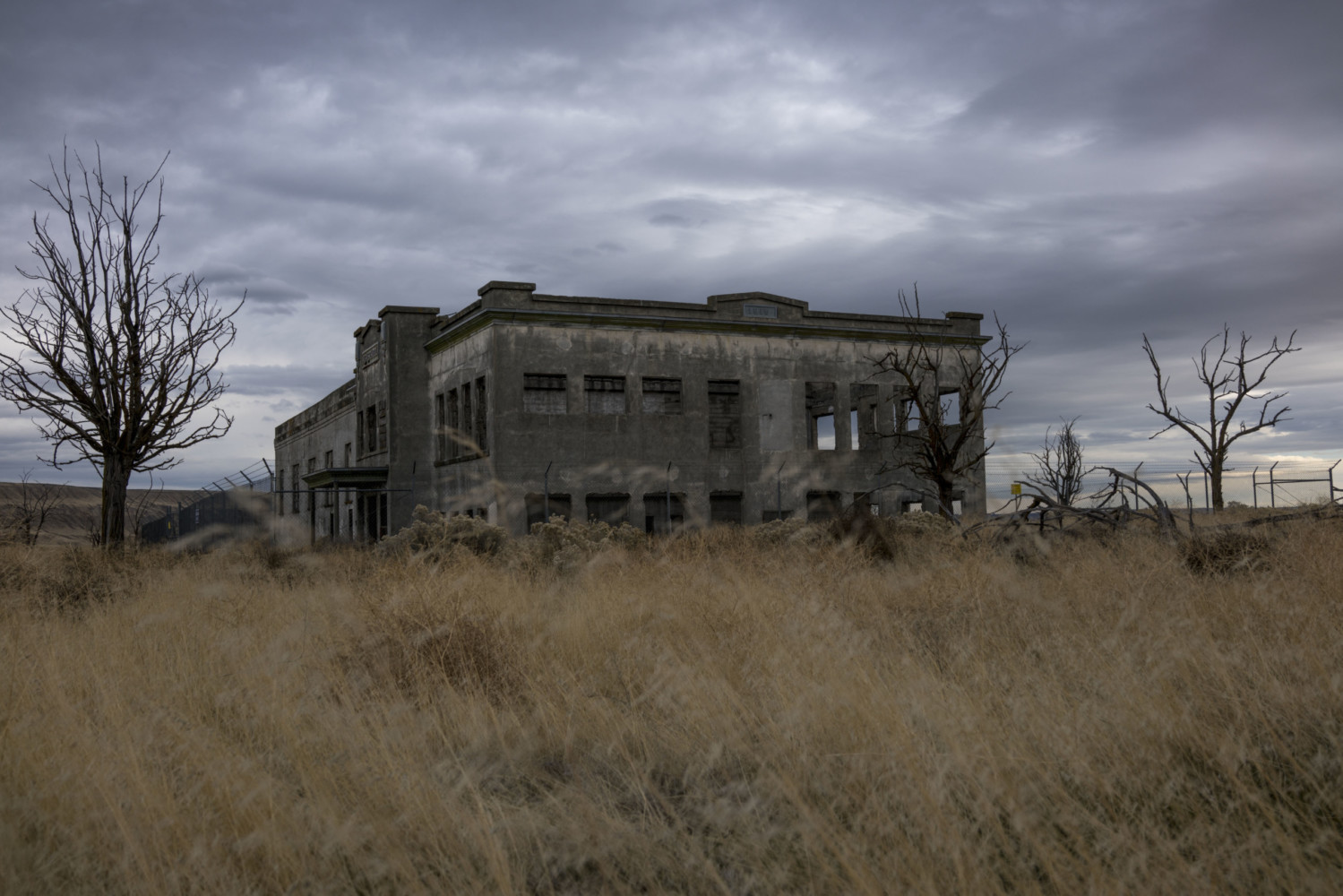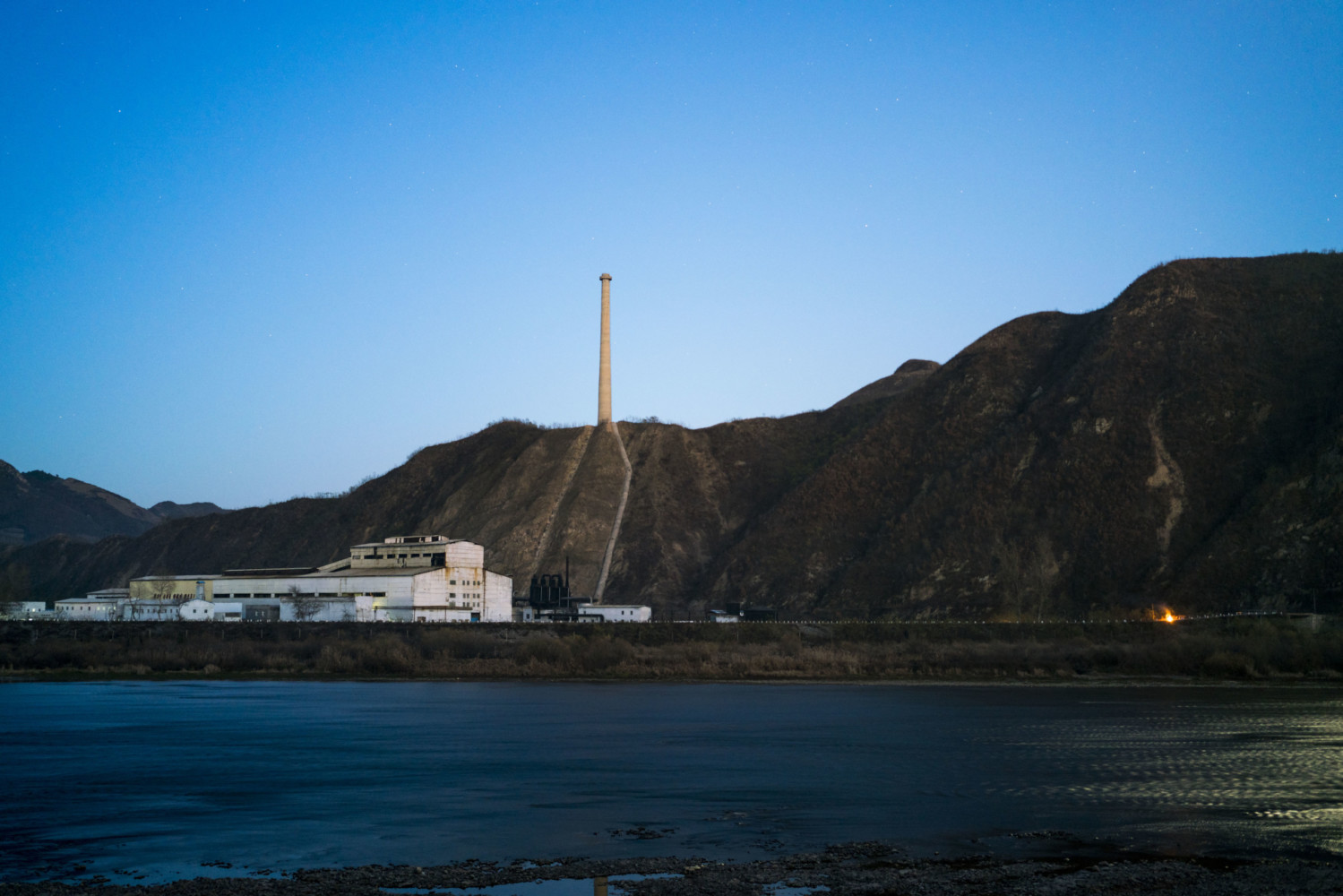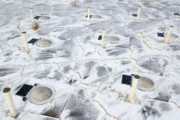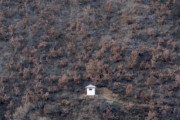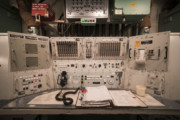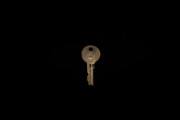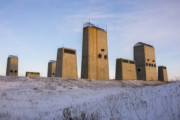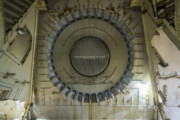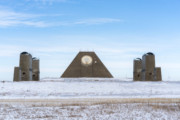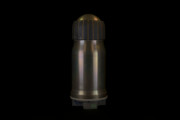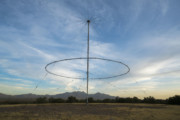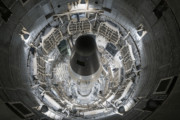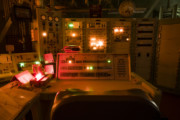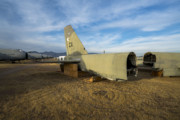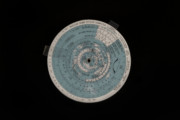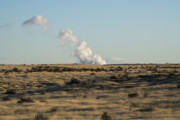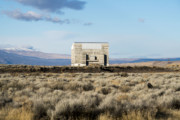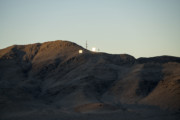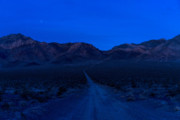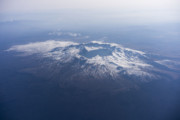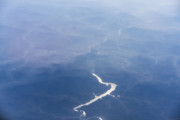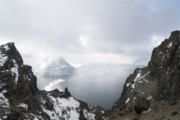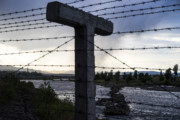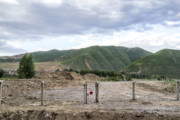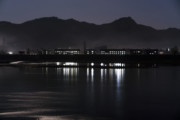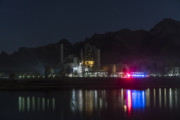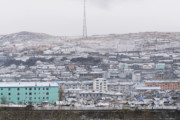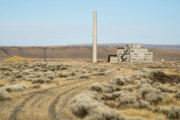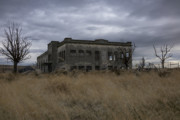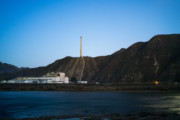Sim Chi Yin DIPTYCH / Left: A factory producing into the night, in Manpo, North Korea, October 2017. / A factory, perhaps making cement, continues production into the night in Manpo, Chagang Province, North Ko (...)
rea, photographed from across the Yalu River from close to the northeastern Chinese city of Ji'an, Jilin province.
Right:
The desk of a commander in the control room of a decommissioned Titan II Missile Site in Arizona, November 2017. / This was the desk of a launch commander in a control center which could fire a Titan II Missile tipped with a 9 megaton thermonuclear warhead – the largest warhead ever deployed on an ICBM by the United States. There was a "No Lone Zone" rule here, meaning there were always at least two members of the crew present. If they received orders to launch a missile, they would each have to turn a launch key at exactly the same time. Once their keys were turned, the missile took 58 seconds to launch and 25 to 30 minutes to reach its target which could be 9,700km away. Crew members were never told where the missiles were targeted at. That launch order never came. This site, operational from 1963 to 1982, is now a museum. © Sim Chi Yin | Magnum Photos
Sim Chi Yin Left: A border guard in his sentry post on the China-North Korea border, close to a suspected North Korean missile base, October 2017. / As seen from the Chinese side, a guard inside a sentry borde (...)
r post in North Korea, along a stretch of the border close to where experts suspect is a missile base at Yongjo-ri, said to be about 20 km inland from the border with the Chinese city of Linjiang. / Right: Minuteman II Missile, South Dakota, United States, November 2017. / A Minuteman II Missile sits in the Delta 09 silo outside of the town of Wall in South Dakota, United States. This intercontinental ballistic missile (ICBM) could travel across 12,500 km and deliver its payload -- a nuclear warhead with a yield equivalent to 1.2 megatons of TNT -- in less than 30 minutes. It was in the US nuclear arsenal between 1965 and 1994. The Minuteman missiles were America's first solid fuel ICBMs. By 1965 there were 1,000 Minuteman ICBMs located in six different missile fields across the Central and Northern Great Plains region which were sparsely populated -- and hence might limit casualties in a nuclear war. The Great Plains were also the furthest area from both the Atlantic and Pacific coastlines, preventing them from being struck by Soviet submarine- launched ballistic missiles. From these locations, missiles could also be launched over the North Pole in order to strike targets in the central Soviet Union. A third generation of this missile, the Minuteman III, is the only ICBM still deployed by the United States. As of 2017, there are over 400 Minuteman III missiles on alert in North Dakota, Wyoming and Montana. © Sim Chi Yin | Magnum Photos
Sim Chi Yin DIPTYCH / Left: A chimney and factory building in Manpo, Chagang Province, North Korea, October 2017. / A chimney and factory building making unspecified products in Manpo, Chagang Province, North (...)
Korea, shot from across the Yalu River near the northeastern Chinese city of Ji'an, Jilin province.
Right:
The B Reactor at the Hanford Site, Washington State, USA -- the world’s first full-scale plutonium reactor, November 2017. / The B Reactor at the Hanford Site, in Washington State, western United States was the world’s first full-scale plutonium reactor. Opened in September 1944, it was where the plutonium for the first ever nuclear test, the Trinity Test in July 1945, and the nuclear bomb dropped on Nagasaki a month later was created, as part of the Manhattan Project. It was shut down in February 1968 and is today preserved as a museum. It was built next to the Columbia River so that the core of the reactor could be cooled by 70,000 gallons (265,000 liters) of the river's water per minute when fully operational. © Sim Chi Yin | Magnum Photos
Sim Chi Yin DIPTYCH / Left:
Fence along the China-North Korea border, near Tumen city, May 2015. / China and North Korea share a 1,420km border, separated by two rivers and a mountain. This gate was in a fen (...)
ce along the China-North Korea border near the Chinese city of Tumen, just across the Tumen River from the North Korean town of Namyang. Tumen City offers clear views into North Korea and attracts Chinese tourists -- and sometimes North Korean fugitives who wade across the river into China. There is a large ethnic Korean population native to Tumen city which is a part of Yanbian prefecture. In early 2015, there were reports of a series of incidents involving North Korean soldiers or citizens coming over and stealing or killing Chinese residents in the Helong area, about 80km west of Tumen. China has stepped up border patrols and built new border fences over stretches of its border with North Korea.
Right:
Atop a hill looking into the Nellis Air Force Range outside Indian Springs, Nevada, near the Nevada Test Site, November 2017. / A facility atop a hill looking into the Nellis Air Force Range outside Indian Springs, Nevada, about 90 km from Las Vegas. The Nellis Air Force Range provides a buffer to the Nevada Test Site, where over 900 nuclear weapons tests were conducted between 1951 and 1992. Combined with the Nevada site, this region is one of the largest unpopulated areas in the US. © Sim Chi Yin | Magnum Photos
Sim Chi Yin Left: Hatches over silos which in the 1970s held missiles meant to shoot down incoming Soviet warheads, North Dakota, November 2017. / A missile field in rural North Dakota near the Canadian border (...)
which held Sprint and Spartan anti-ballistic missiles designed to intercept attacking nuclear warheads from Soviet missiles coming over the North Pole. These were deployed at the Stanley R. Mickelsen Safeguard Complex near Langdon, North Dakota, in the mid 1970s – a radar and anti-ballistic missile defence site which was shuttered by 1979.
Right:
The North Korean city of Hyesan, about 120km from North Korea's nuclear test site, October 2017. / The city of Hyesan in North Korea's Ryanggang province sits across the Yalu River from the Chinese border town of Changbai. Hyesan is 120 km from the Punggye-ri nuclear test site where North Korea is estimated to have conducted six underground nuclear tests since 2006. Japanese news reports in October (2017) said that a tunnel at the site had collapsed, killing as many as 200 North Koreans. Pyongyang's latest nuclear test, on September 3 (2017) recorded as a 6.3-magnitude earthquake in North Korea’s northeast. © Sim Chi Yin | Magnum Photos
Sim Chi Yin USA. November, 2017. Hatches over silos which in the 1970s held missiles meant to shoot down incoming Soviet warheads, North Dakota. / A missile field in rural North Dakota near the Canadian border (...)
which held Sprint and Spartan anti-ballistic missiles designed to intercept attacking nuclear warheads from Soviet missiles coming over the North Pole. These were deployed at the Stanley R. Mickelsen Safeguard Complex near Langdon, North Dakota, in the mid 1970s – a radar and anti-ballistic missile defence site which was shuttered by 1979. © Sim Chi Yin | Magnum Photos
Sim Chi Yin Left: A border guard in his sentry post on the China-North Korea border, close to a suspected North Korean missile base, October 2017. / As seen from the Chinese side, a guard inside a sentry borde (...)
r post in North Korea, along a stretch of the border close to where experts suspect is a missile base at Yongjo-ri, said to be about 20 km inland from the border with the Chinese city of Linjiang. / Right: Minuteman II Missile, South Dakota, United States, November 2017. / A Minuteman II Missile sits in the Delta 09 silo outside of the town of Wall in South Dakota, United States. This intercontinental ballistic missile (ICBM) could travel across 12,500 km and deliver its payload -- a nuclear warhead with a yield equivalent to 1.2 megatons of TNT -- in less than 30 minutes. It was in the US nuclear arsenal between 1965 and 1994. The Minuteman missiles were America's first solid fuel ICBMs. By 1965 there were 1,000 Minuteman ICBMs located in six different missile fields across the Central and Northern Great Plains region which were sparsely populated -- and hence might limit casualties in a nuclear war. The Great Plains were also the furthest area from both the Atlantic and Pacific coastlines, preventing them from being struck by Soviet submarine- launched ballistic missiles. From these locations, missiles could also be launched over the North Pole in order to strike targets in the central Soviet Union. A third generation of this missile, the Minuteman III, is the only ICBM still deployed by the United States. As of 2017, there are over 400 Minuteman III missiles on alert in North Dakota, Wyoming and Montana. © Sim Chi Yin | Magnum Photos
Sim Chi Yin October, 2017. A border guard in his sentry post on the China-North Korea border, close to a suspected North Korean missile base. / As seen from the Chinese side, a guard inside a sentry border pos (...)
t in North Korea, along a stretch of the border close to where experts suspect is a missile base at Yongjo-ri, said to be about 20 km inland from the border with the Chinese city of Linjiang. © Sim Chi Yin | Magnum Photos
Sim Chi Yin USA. November, 2017. The deputy commander's desk at the Oscar-Zero Missile Alert Facility in Cooperstown, North Dakota. / The Deputy Missile Control Center Commander’s desk at the Oscar-Zero Missi (...)
le Alert Facility. The red box top left is where the missile launch keys were stored and the bottom right console is where the deputy commander would put his key in case of a launch order. This facility in Cooperstown, North Dakota was part of a network of bases where missiles were deployed in the 1960s across the Great Plains, as part of America's strategy of nuclear deterrence against the Soviet Union. The facility was designed to launch Minuteman II missiles. In case of a nuclear attack, the two missileers could remain underground for up to nine weeks. The facility was decommissioned with the signing of the Strategic Arms Reduction Treaty (START) in 1991. © Sim Chi Yin | Magnum Photos
Sim Chi Yin USA. 2017.
A launch key for Minuteman II missiles from the Oscar-Zero Missile Alert Facility in Cooperstown, North Dakota. This key, along with a second one, would have to be turned at exactly th (...)
e same time by the commander and his deputy upon receiving a launch order. The facility was part of a network of bases where missiles were deployed in the 1960s across the Great Plains, as part of America's strategy of nuclear deterrence against the Soviet Union. The facility was designed to launch Minuteman II missiles. In case of a nuclear attack, the two missileers could remain underground for up to nine weeks. The facility was decommissioned with the signing of the Strategic Arms Reduction Treaty (START) in 1991. © Sim Chi Yin | Magnum Photos
Sim Chi Yin USA. November, 2017. Inside an anti-ballistic missile defense radar facility, North Dakota. / The back of one of four array antenna, each on one side of a pyramidal structure that was the Missile S (...)
ite Control Building at the Stanley R Mickelsen SAFEGUARD Complex. This anti-ballistic missile defense site - the only one to be built in the US -- was designed to detect and intercept attacking nuclear warheads from Soviet missiles coming over the North Pole. Nuclear-tipped Sprint and Spartan anti-ballistic missiles were deployed at the site to shoot down the incoming Soviet missiles. The facility, built in the early to mid 1970s at a cost of US$5.7 billion, near Langdon, North Dakota, was fully operational for only a day in October 1975 before Congress voted to shut it down. At the time it had one of the most advanced radar systems, and boasted one of the most powerful computers, in the world. Because of its effect as a deterrent to the Soviets, it is seen as having been a bargaining chip for the US in the SALT treaties. © Sim Chi Yin | Magnum Photos
Sim Chi Yin An anti-ballistic missile defense radar facility, North Dakota. / The pyramid-shaped Missile Site Control Building stands in the middle of the Stanley R Mickelsen SAFEGUARD Complex. This anti-balli (...)
stic missile defense site -- the only one to be built in the US -- was designed to detect and intercept attacking nuclear warheads from Soviet missiles coming over the North Pole. Nuclear-tipped Sprint and Spartan anti-ballistic missiles were deployed at the site to shoot down the incoming Soviet missiles. The facility, built in the early to mid 1970s at a cost of US$5.7 billion, near Langdon, North Dakota, was fully operational for only a day in October 1975 before Congress voted to shut it down. At the time it had one of the most advanced radar systems, and boasted one of the most powerful computers, in the world. Because of its effect as a deterrent to the Soviets, it is seen as having been a bargaining chip for the US in the SALT treaties. USA. November, 2017. © Sim Chi Yin | Magnum Photos
Sim Chi Yin USA. 2017. ‘Cuban Missile Crisis Matryoshka Dolls’.
These artifacts were created by an unknown artist who painted important figures in the 1962 Cuban Missile Crisis onto traditional Matryoshka dol (...)
ls. US President John F. Kennedy, Soviet leader Nikita Kruschev, Cuban leader Fidel Castro and Soviet Ambassador to the US Anatoly Dobrynin are featured alongside Soviet missiles, a U-2 spy plane, Soviet and American flags and the word ‘Peace’ in English, Russian and Spanish. The Cuban Missile Crisis was a 13-day standoff between the US and the USSR over the installation of nuclear-tipped Soviet missiles in Cuba that brought the two countries to the brink of nuclear war. Courtesy of the National Atomic Testing Museum, Las Vegas, Nevada. © Sim Chi Yin | Magnum Photos
Sim Chi Yin USA. 2017. The W-80 warhead developed by Los Alamos National Lab between June 1976 and January 1981. This warhead is used on three different missiles, the BGM0109 Tomahawk SLCM (Sea Launched Cruise (...)
Missile), the AGM-86B ALCM (Air Launched Cruise Missile), and AGM-129 ACM (Advanced Cruise Missile, air launched weapon with stealth technology). It has a variable yield between 5kt and 150kt.
This warhead was tested in two different shots. Operation Guardian, Baseball, on 1/15/1981. And Operation Praetorian, Jornada, on 1/28/1982.
Courtesy National Atomic Testing Museum, Nevada. © Sim Chi Yin | Magnum Photos
Sim Chi Yin USA. 2017. An antenna used by crew members of missile site 571-7, which could fire a Titan II missile tipped with a 9 megaton thermonuclear warhead – largest warhead every deployed on an ICBM by th (...)
e United States.
This antenna was used for long-range communications.
The crew would check in with an Atomic Clock in Boulder, Colorado at the beginning of every shift to make sure they had the correct time in case of a need to launch. © Sim Chi Yin | Magnum Photos
Sim Chi Yin A Titan II Missile in its silo at a former intercontinential ballistic missile site in Arizona. / A Titan II Missile in its silo at a former intercontinential ballistic missile site in Arizona, now (...)
the Titan Missile Museum. The Titan II was the largest and heaviest missile ever built by the United States. The missile was 31.3 m long and 3.05 m wide. It weighed 149,700 kg when fully fueled and had a range of 15,000 km. This is the last of 54 such missiles that were clustered in Arizona, Arkansas and Kansas during the Cold War; the rest have been destroyed. USA. November, 2017. © Sim Chi Yin | Magnum Photos
Sim Chi Yin USA. Novemberm 2017. The desk of a commander in a control room of a decommissioned Titan II Missile Site in Arizona. / This was the desk of a launch commander in a control center which could fire a (...)
Titan II Missile tipped with a 9 megaton thermonuclear warhead – the largest warhead ever deployed on an ICBM by the United States. There was a "No Lone Zone" rule here, meaning there were always at least two members of the crew present. If they received orders to launch a missile, they would each have to turn a launch key at exactly the same time. Once their keys were turned, the missile took 58 seconds to launch and 25 to 30 minutes to reach its target which could be 9,700km away. Crew members were never told where the missiles were targeted at. That launch order never came. This site, operational from 1963 to 1982, is now a museum. © Sim Chi Yin | Magnum Photos
Sim Chi Yin USA. Novemberm 2017. A decommissioned Boeing B52 bomber at the Davis-Monthan Air Force Base Boneyard in Tucson, Arizona. / A decommissioned Boeing B52 bomber at the Davis-Monthan Air Force Base Bo (...)
neyard in Tucson, Arizona. This B52 had its tail removed and placed at a 45 degree angle to the rest of the airplane to demonstrate the US’s compliance with the New START agreement with Russia, which was ratified in 2010. The US Air Force keeps these B52s for spare parts. © Sim Chi Yin | Magnum Photos
Sim Chi Yin USA. 2017. ‘Nuclear Bomb Effects Computer’.
This circular slide rule was designed to tell the user how much damage they could expect from a nuclear explosion. It can calculate the extent of physic (...)
al damage a nuclear blast can cause as well as the amount of radiation that could be emitted in different kinds of explosions. Small circular slide rules of this type were available to the public and commonly used by the US Civil Defense service from the 1950s and beyond. Courtesy of the National Atomic Testing Museum, Las Vegas, Nevada. © Sim Chi Yin | Magnum Photos
Sim Chi Yin USA. 2017. Steam rises from the Columbia River Generating Station, a nuclear power plant only a few kilometers from the Hanford Site. It would have been common for local people to see steam rising (...)
from the nine nuclear reactors that were once producing plutonium for atomic weapons at the Hanford site. © Sim Chi Yin | Magnum Photos
Sim Chi Yin USA. 2017. The C Reactor, which was completed in 1952, was the sixth nuclear reactor built at the Hanford site. It ran for 16 years before being shut down in 1969. The C Reactor was the first of H (...)
anford’s nine plutonium production reactors to be placed in Interim Safe Storage, also knwn as ‘cocooned.’ Reactor cocooning is designed to keep the reactor shut for 75 years to allow the radiation levels to decay to a point where the reactor could be dismantled and disposed of © Sim Chi Yin | Magnum Photos
Sim Chi Yin USA. November, 2017. Atop a hill looking into the Nellis Air Force Range outside Indian Springs, Nevada, near the Nevada Test Site. / A facility atop a hill looking into the Nellis Air Force Range (...)
outside Indian Springs, Nevada, about 90 km from Las Vegas. The Nellis Air Force Range provides a buffer to the Nevada Test Site, where over 900 nuclear weapons tests were conducted between 1951 and 1992. Combined with the Nevada site, this region is one of the largest unpopulated areas in the US. © Sim Chi Yin | Magnum Photos
Sim Chi Yin USA. November, 2017. On the fringes of the Nevada Test Site, where over 900 nuclear tests were done 1951 to 1992. / On the other side of these mountains lies the Sedan Crater, the largest crater of (...)
those created by over 900 nuclear tests on the Nevada Test Site between 1951 and 1992. Measuring 390 by 100 m, the Sedan Crater was created on July 6, 1962 by a 104-kiloton-of-TNT thermonuclear explosion. The last nuclear test the US did was at the Test Site, in September 1992. © Sim Chi Yin | Magnum Photos
Sim Chi Yin October 28, 2017. Looking from China into North Korea over Mount Paektu, elevation 2,744 m, an active volcano on the border of the two countries. The mountain and the crater lake formed by a volcan (...)
ic eruption are divided between North Korea and China. The highest mountain on the Korean peninsula and northeast China, it is regarded by North and South Koreans as a sacred place that is their countries’ spiritual home. Imagery of this mountain features in many North Korean propaganda paintings. © Sim Chi Yin | Magnum Photos
Sim Chi Yin Flying over the China-North Korea border. / China and North Korea share a 1,420km border, separated by two rivers -- the Yalu and Tumen -- and a mountain. China has stepped up border patrols and b (...)
uilt new border fences over stretches of its border with North Korea. October 2017. © Sim Chi Yin | Magnum Photos
Sim Chi Yin Looking into North Korea from the north peak of Mount Paektu, elevation 2,744 m, an active volcano on the border of North Korea and China. The mountain and the crater lake formed by a volcanic erup (...)
tion are divided between North Korea and China. The highest mountain on the Korean peninsula and northeast China, it is regarded by North and South Koreans as a sacred place that is their countries’ spiritual home. Imagery of this mountain features in many North Korean propaganda paintings. October 28, 2017. © Sim Chi Yin | Magnum Photos
Sim Chi Yin CHINA. 2015. Fence along the China-North Korea border, near Tumen city, May 2015. / China and North Korea share a 1,420km border, separated by two rivers and a mountain. This gate was in a fence a (...)
long the China-North Korea border near the Chinese city of Tumen, just across the Tumen River from the North Korean town of Namyang. Tumen City offers clear views into North Korea and attracts Chinese tourists -- and sometimes North Korean fugitives who wade across the river into China. There is a large ethnic Korean population native to Tumen city which is a part of Yanbian prefecture. In early 2015, there were reports of a series of incidents involving North Korean soldiers or citizens coming over and stealing or killing Chinese residents in the Helong area, about 80km west of Tumen. China has stepped up border patrols and built new border fences over stretches of its border with North Korea. © Sim Chi Yin | Magnum Photos
Sim Chi Yin 2017. A factory continues production into the night in Manpo, Chagang Province, North Korea, photographed from across the Yalu River from close to the northeastern Chinese city of Ji'an, Jilin prov (...)
ince. About 35 km inland from here is Kangye which is thought by scholars to be the centre of the North Korean munitions industry and where the centrifuges used in nuclear weaponry are manufactured. © Sim Chi Yin | Magnum Photos
Sim Chi Yin October, 2017, A factory producing into the night, in Manpo, North Korea. / A factory, perhaps making cement, continues production into the night in Manpo, Chagang Province, North Korea, photograph (...)
ed from across the Yalu River from close to the northeastern Chinese city of Ji'an, Jilin province. About 35 km inland from here is Kangye which is thought by scholars to be the centre of the North Korean munitions industry and where the centrifuges used in nuclear weaponry are manufactured. © Sim Chi Yin | Magnum Photos
Sim Chi Yin October, 2017. The North Korean city of Hyesan, about 120km from North Korea's nuclear test site. / The city of Hyesan in North Korea's Ryanggang province sits across the Yalu River from the Chines (...)
e border town of Changbai. Hyesan is 120 km from the Punggye-ri nuclear test site where North Korea is estimated to have conducted six underground nuclear tests since 2006. Japanese news reports in October (2017) said that a tunnel at the site had collapsed, killing as many as 200 North Koreans. Pyongyang's latest nuclear test, on September 3 (2017) recorded as a 6.3-magnitude earthquake in North Korea’s northeast. © Sim Chi Yin | Magnum Photos
Sim Chi Yin USA. November, 2017. The B Reactor at the Hanford Site, Washington State, USA -- the world’s first full-scale plutonium reactor, November 2017. / The B Reactor at the Hanford Site, in Washington St (...)
ate, western United States was the world’s first full-scale plutonium reactor. Opened in September 1944, it was where the plutonium for the first ever nuclear test, the Trinity Test in July 1945, and the nuclear bomb dropped on Nagasaki a month later was created, as part of the Manhattan Project. It was shut down in February 1968 and is today preserved as a museum. It was built next to the Columbia River so that the core of the reactor could be cooled 70,000 gallons (265,000 liters) of the river's water per minute when fully operational. © Sim Chi Yin | Magnum Photos
Sim Chi Yin USA. 2017. The Hanford High School building is one of the only buildings from the period before the Hanford Site was seized by the US government that is still standing. Opened in 1906, it was close (...)
d in 1943 when the US government took over more than 600 square miles of land for the Manhattan Project. The town of Hanford was a small, agricultural community. Along with the town of White Bluffs, these two communities were forced to move out. Soon afterwards, 51,000 workers moved into the area to being construction of what is now known as the Hanford Nuclear Reservation. © Sim Chi Yin | Magnum Photos
Sim Chi Yin 2017. A chimney and factory building making unspecified products in Manpo, Chagang Province, North Korea, shot from across the Yalu River near the northeastern Chinese city of Ji'an, Jilin province (...)
. About 35 km inland from here is Kangye which is thought by scholars to be the centre of the North Korean munitions industry and where the centrifuges used in nuclear weaponry are manufactured. © Sim Chi Yin | Magnum Photos
